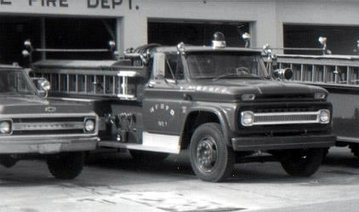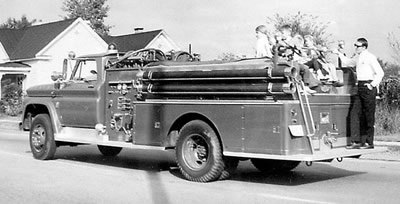Since 1921, The Wake Forest Fire Department has been providing fire protection to Wake Forest and surrounding areas. The department was formed to provide services to three main areas of Wake Forest: The Town (downtown area), Wake Forest College (current Southeastern Baptist Theological Seminary, and the Cotton Mill (no longer in operation).
Over the past 99 years, the Wake Forest Fire Department has grown to provide emergency medical, technical rescue, hazardous material, water rescue, fire investigation, and of course, fire protection services. From the early years - with nothing but volunteers and one fire house to the current department of over 75 career 24-hour staff, dedicated volunteers, and five fire houses, the members of the Wake Forest Fire Department continue to strive to live our motto; "saving lives, our prime goal."
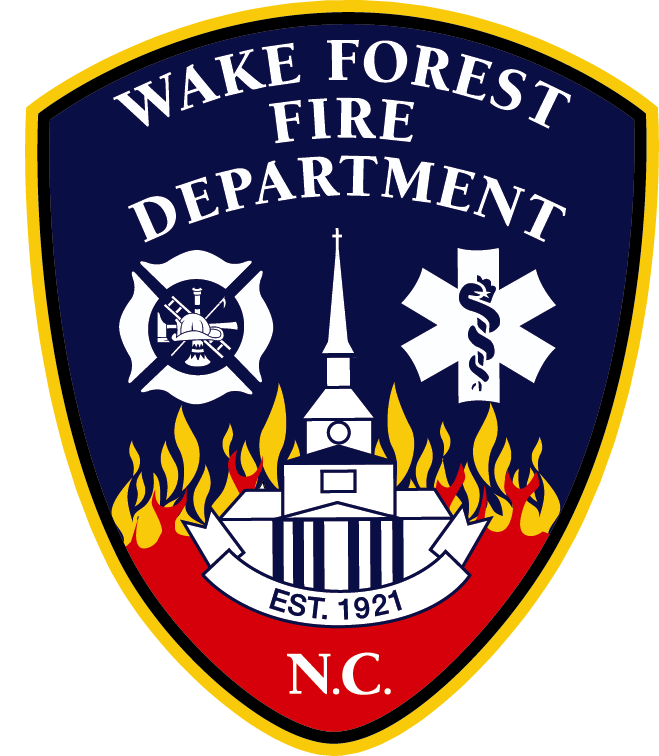
2020, June 1st, 2020. Academy 0919 graduates after an 8 month academy. The academy graduated 12 recruits who were hired for the new ladder company being placed into service at Station #2. The members of Academy 0919 are: John Carr, Korey Floyd, Steven Haag, Zack Helms, Damian Johnson, Keith Lee, Ryan Lynn, Robert Mitchell, Samuel Scales, Matthew Smith, Brice Strickland, and Jabez Tsantles.
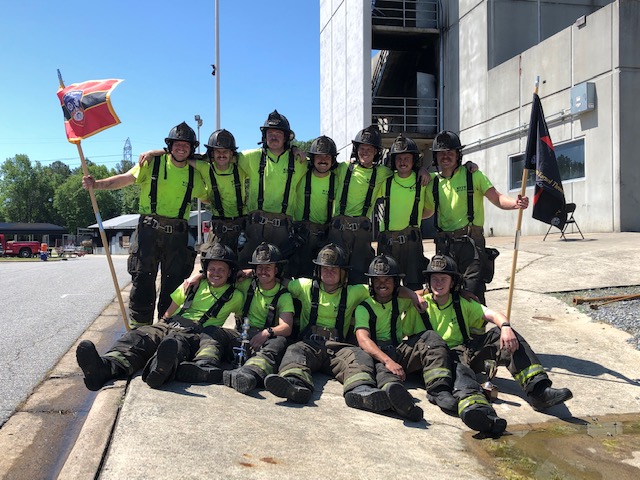 | 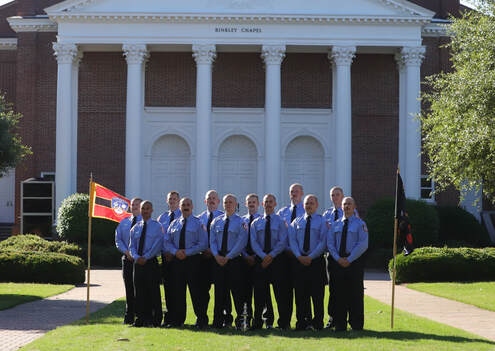 |
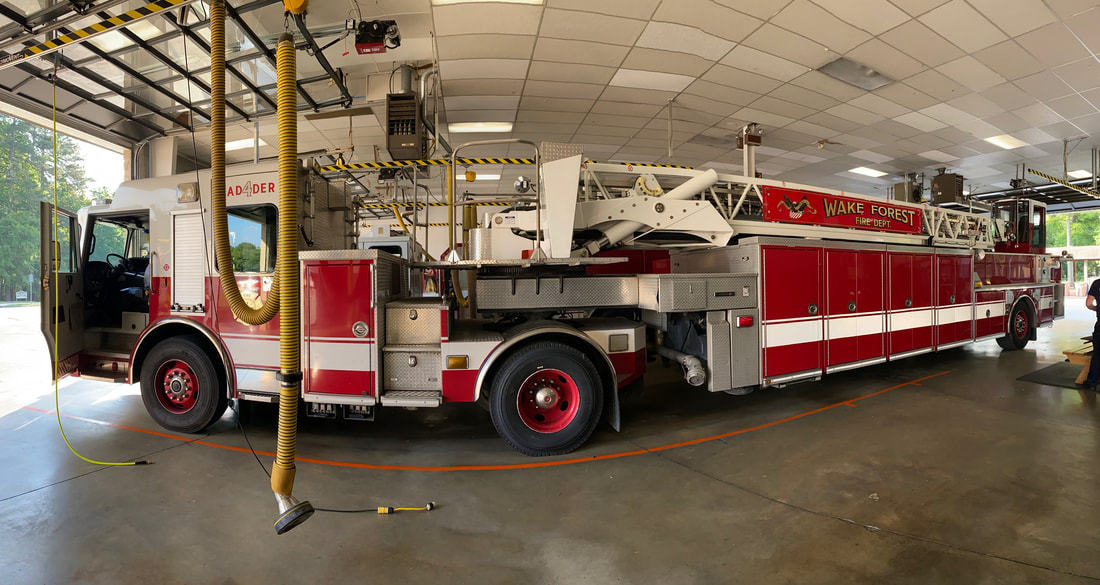 | 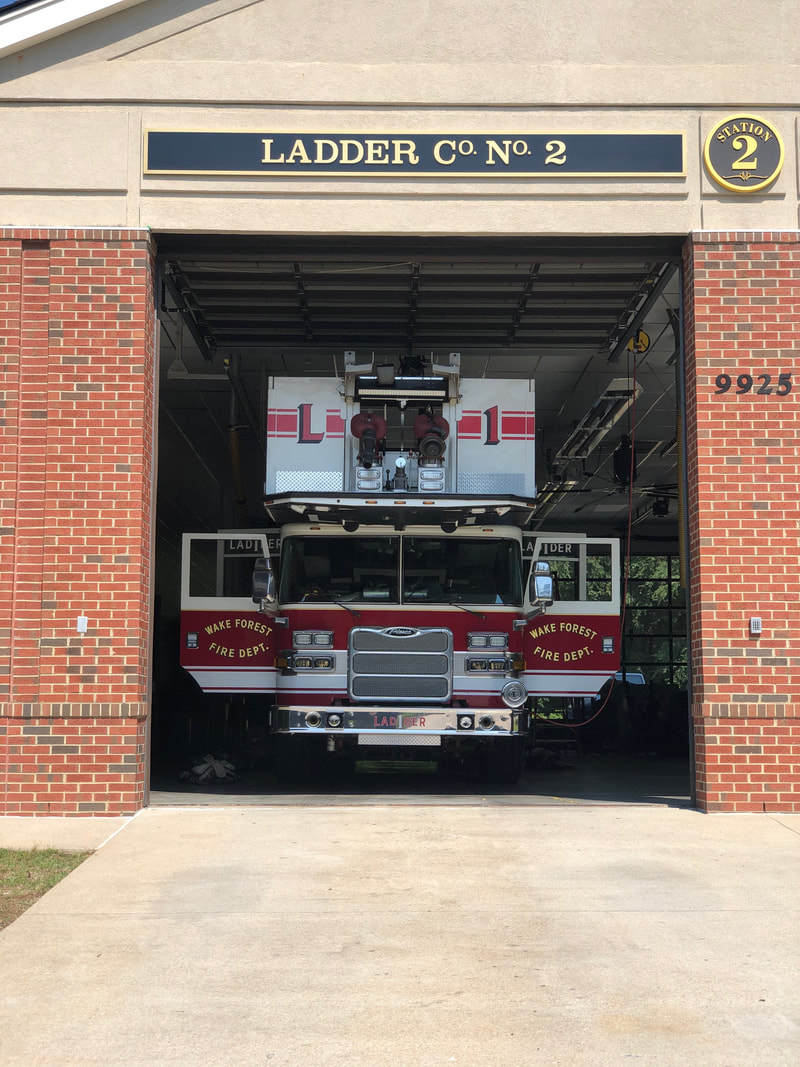 |
2020, July 1st - Wake Forest Fire Department Inc. officially ceases operations and becomes a department under the Town of Wake Forest. For 37 years, the Wake Forest Fire Department Inc. contracted fire services with the Town of Wake Forest and served the Wakette Fire District of Wake County.
2020, August 11th- WFFD takes delivery of a 2019 Rosenbauer engine and is placed into service as Engine #1. The apparatus has 1000 gallons of water, a 1500 gpm pump, and a 20 gallon foam tank. A private wet-down ceremony is held by on duty staff due to COVID-19 restrictions.
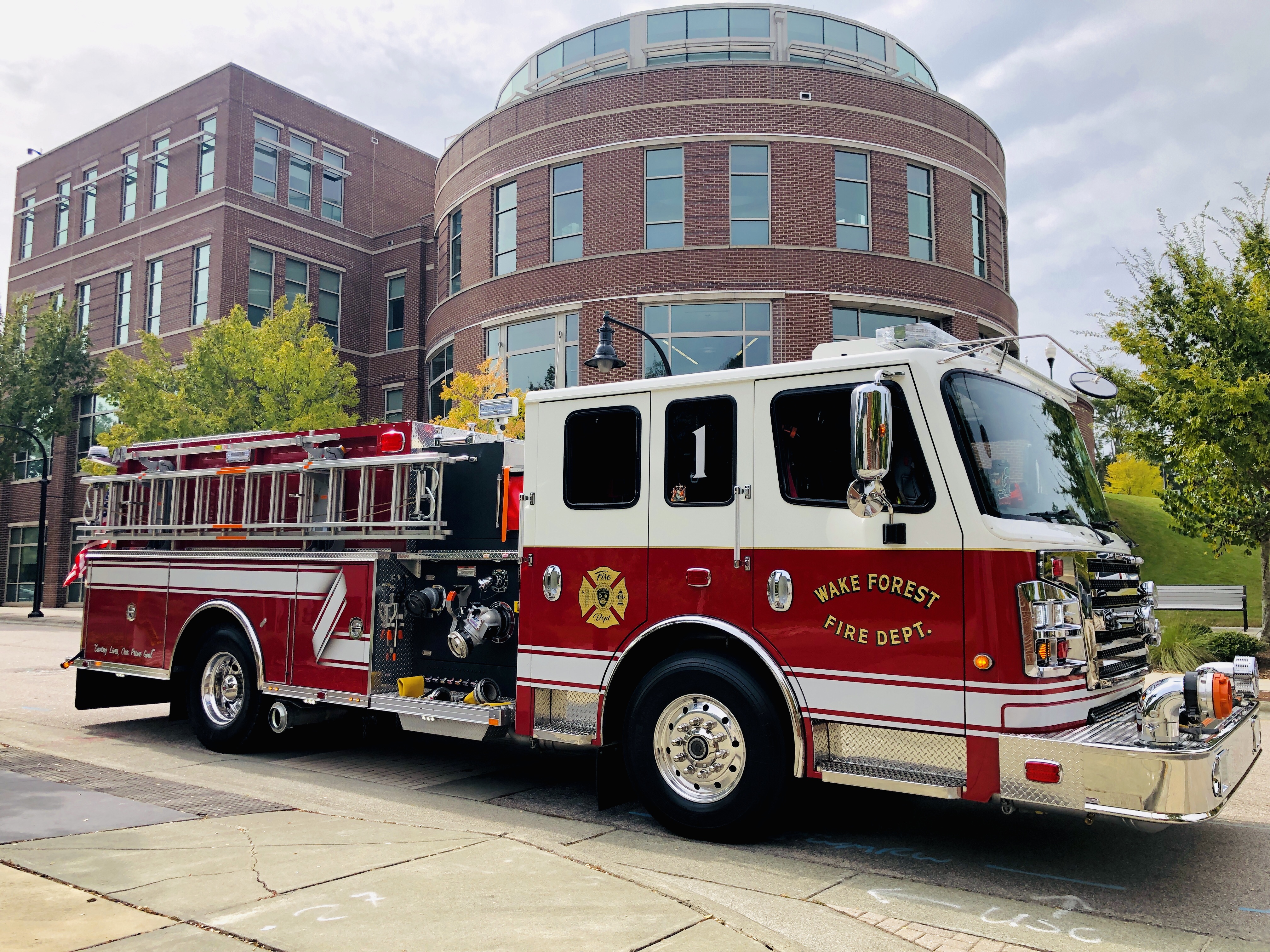 | 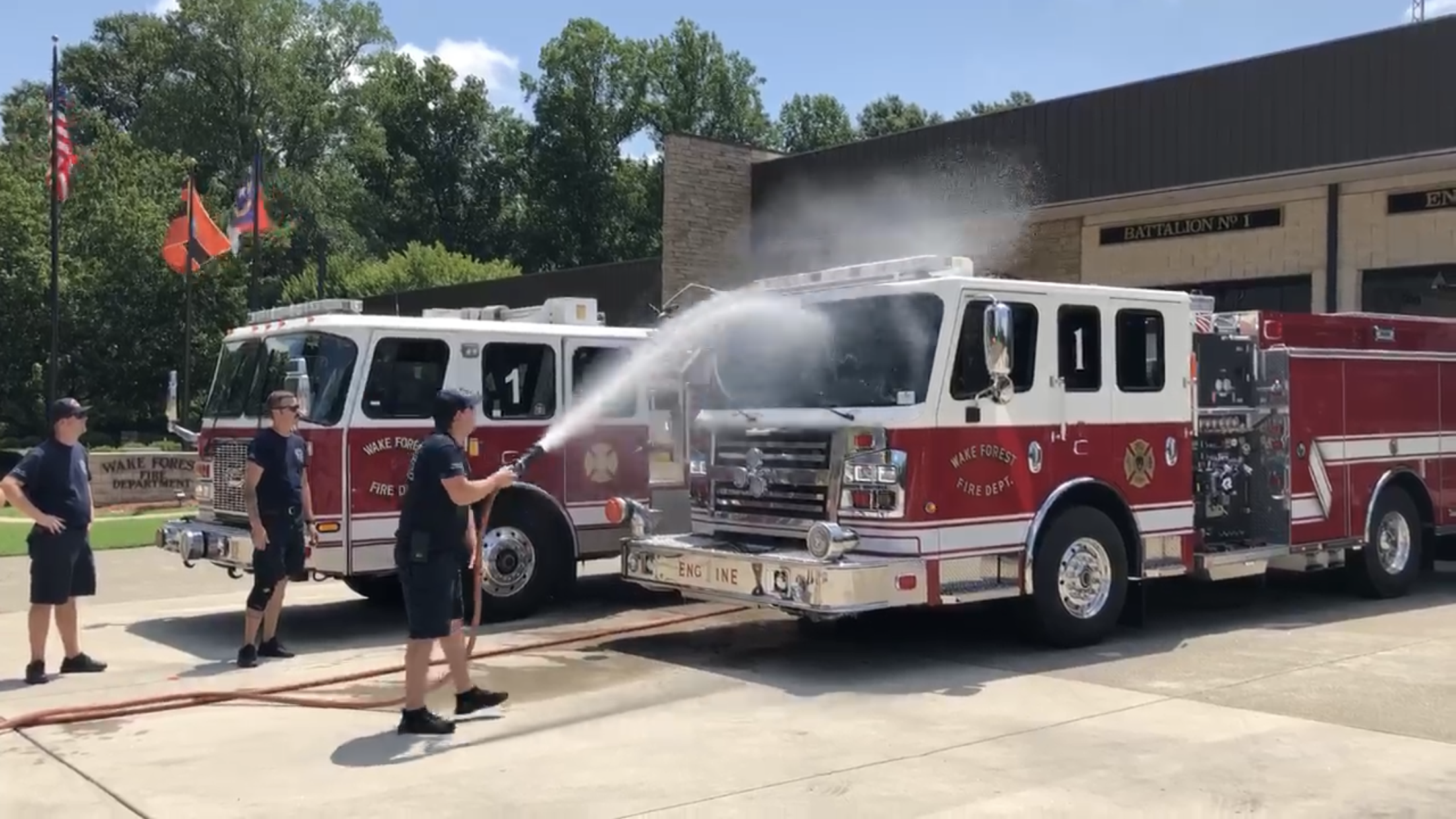 |
2021, January 2nd. Suppression staff from WFFD begin getting the Pfizer COVID-19 vaccine through Wake County Health and Human Services. This is an effort to reduce the contraction and spread of the deadly pandemic.
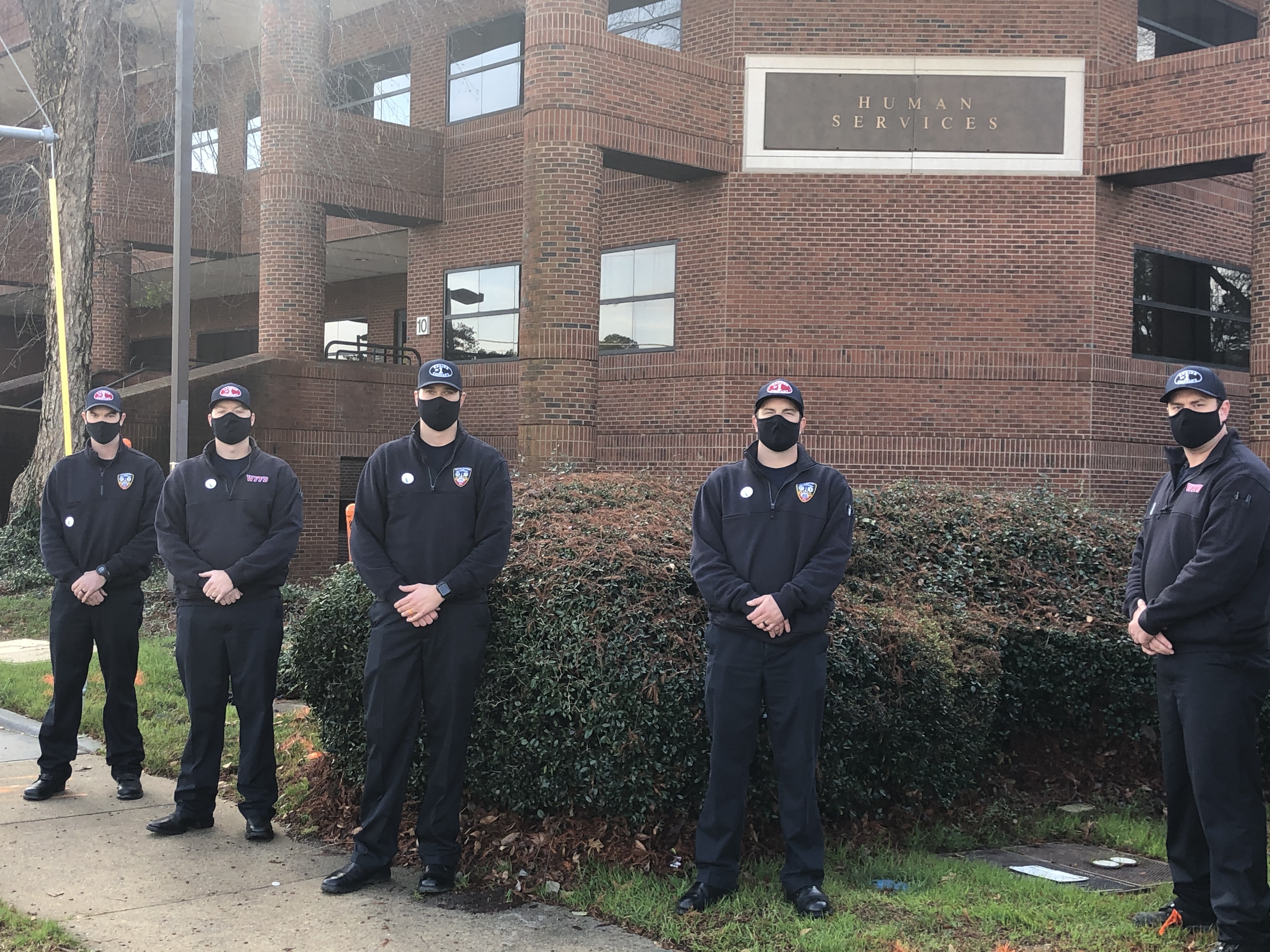
2021, March 2nd. WFFD takes delivery and places into service Ladder #1, the first Tractor Drawn Aerial (tiller) built for the department. This is the first apparatus purchased by the Town of Wake Forest since the fire department became a Town department. It is a 2020 Spartan Tractor Drawn Aerial with a 105' ladder, 200 gallon water tank, and a 1500 GPM pump. A wet-down ceremony is held at Station 1 with on duty staff and a limited list of guests from the Town.
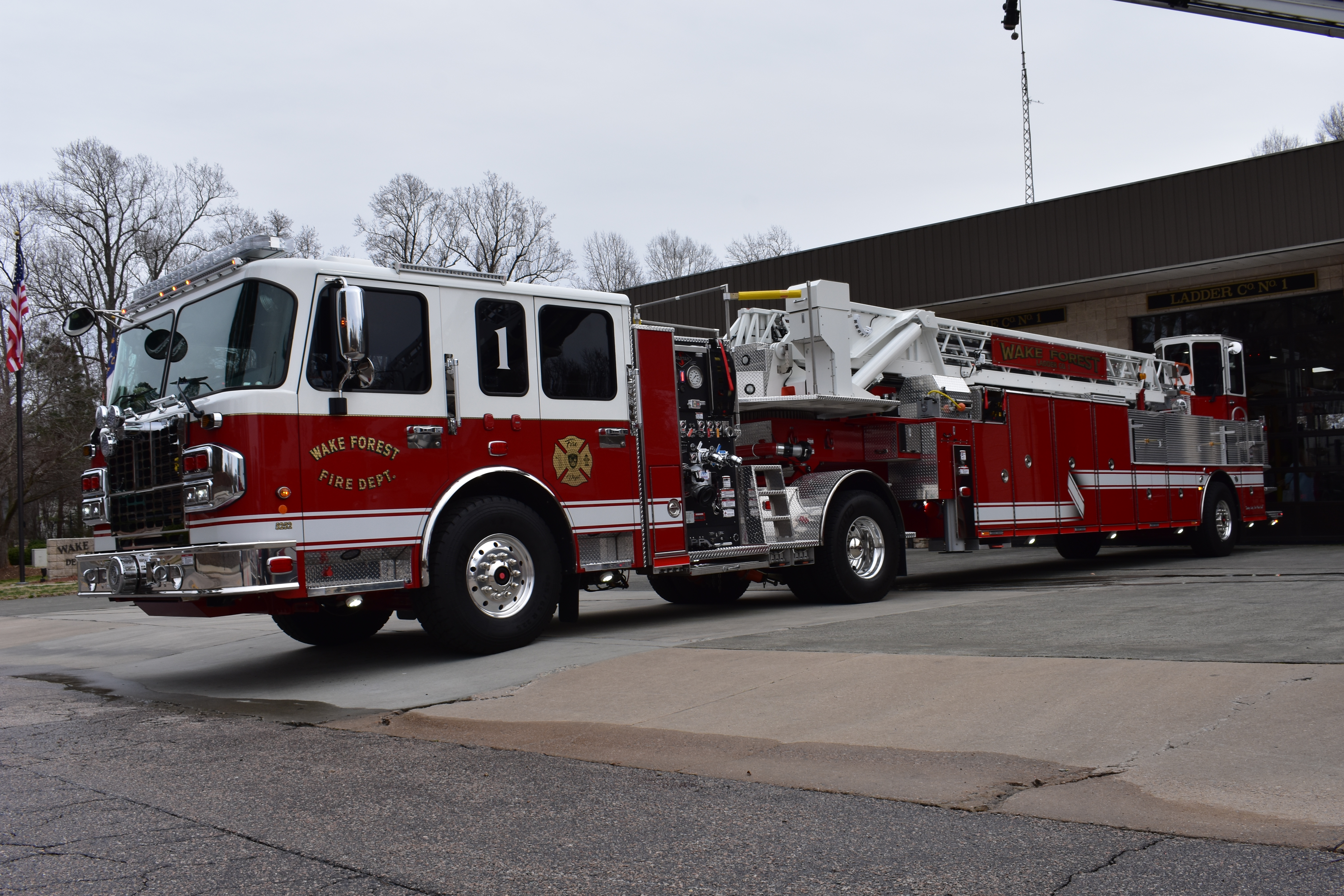 | 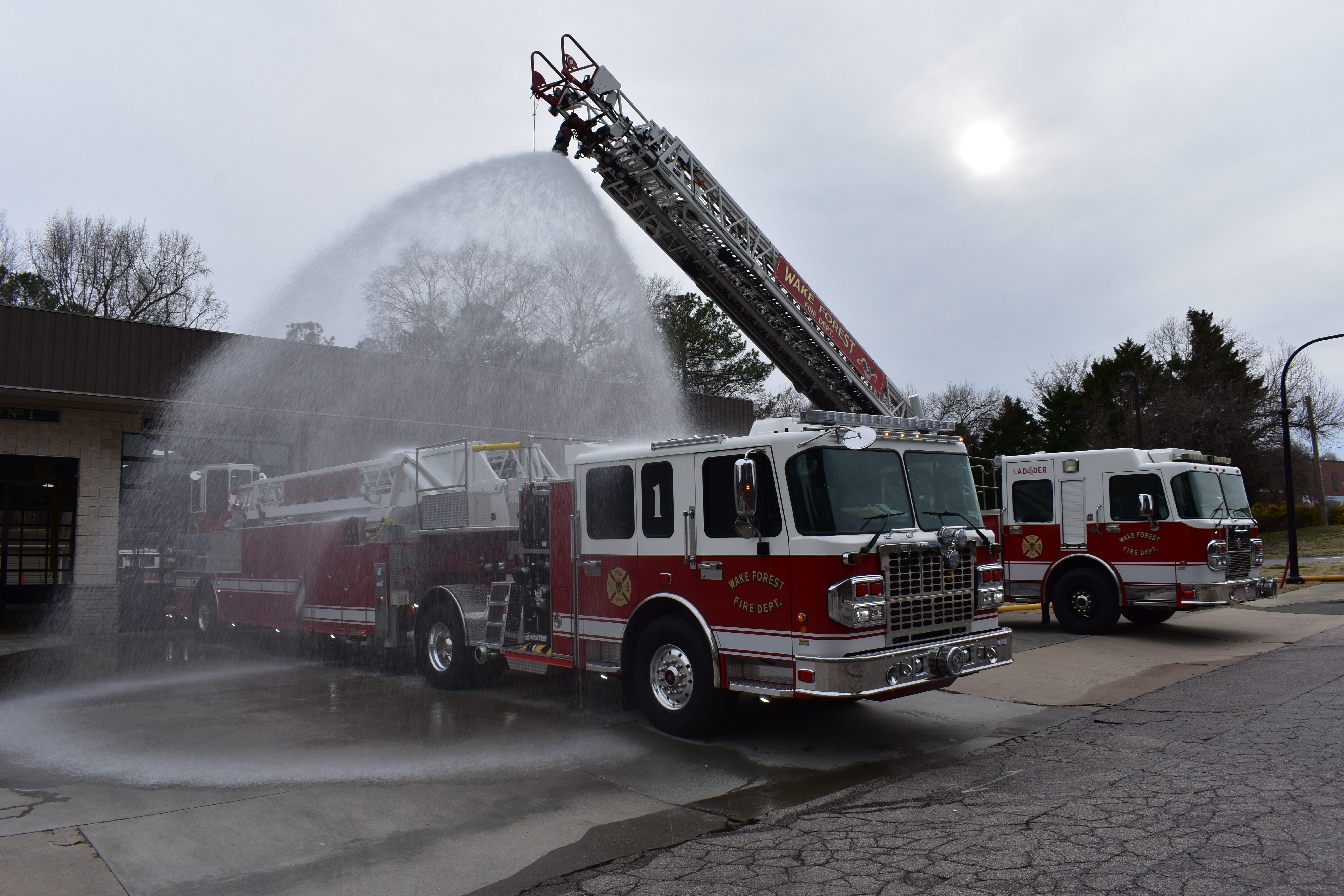 | 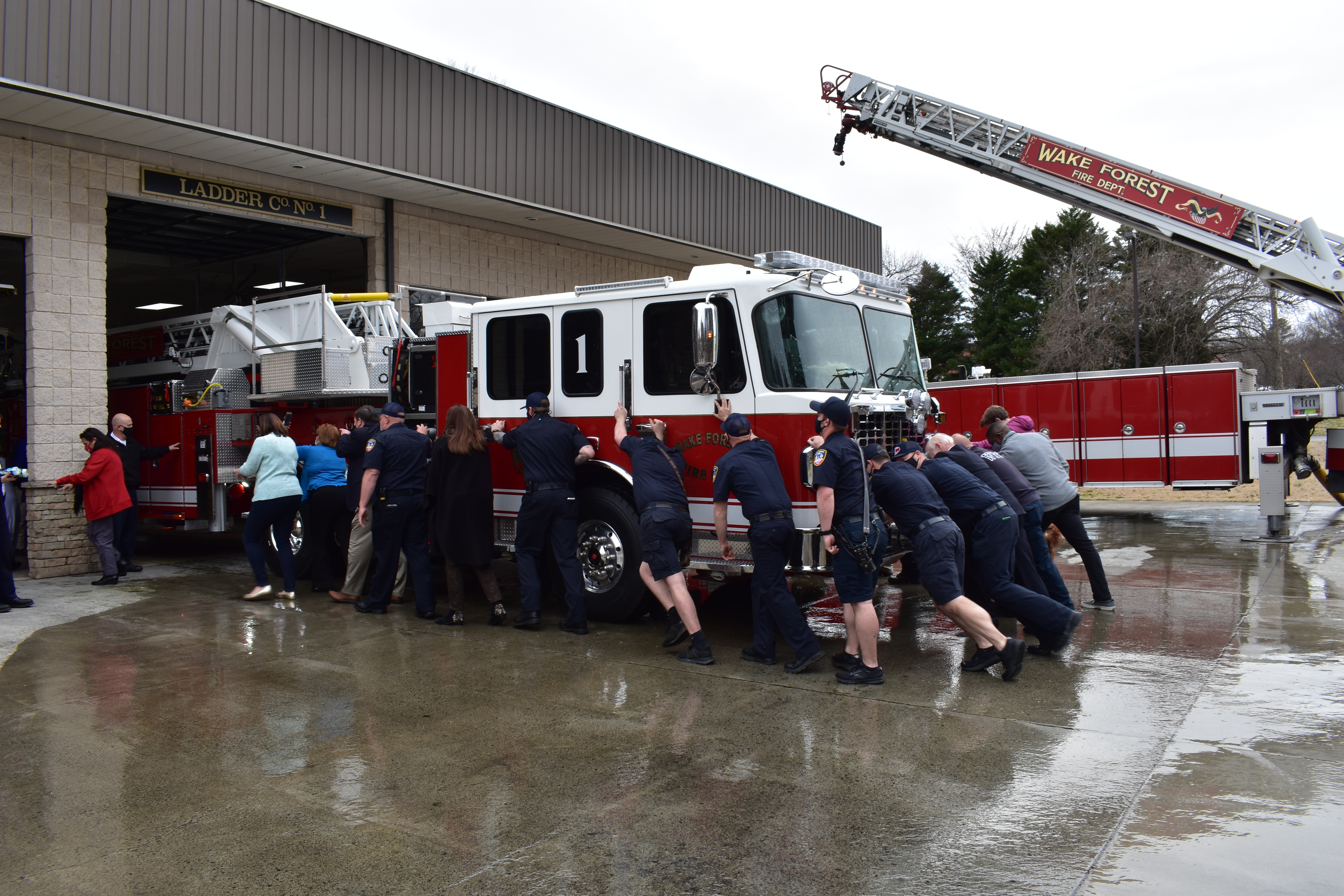 |
2021, April 1st. WFFD begins wearing Autism Awareness Shirts on duty in honor of Fire Chief Ron Early's Son, Kyle Early who lived with ASD. The initiative came from the Fire Chief, his wife Tammy, and Capt. Justin Brown. In a quote from Chief Early: “Autism Awareness is near and dear to our hearts,” Early said. “It is our hope that by bringing awareness to autism spectrum disorder, we can help people better understand individuals diagnosed with ASD with a more loving heart, patience, and kindness.”
In response to community support, a purchasable shirt was designed and over 1000 shirts were sold reaching all across the country.
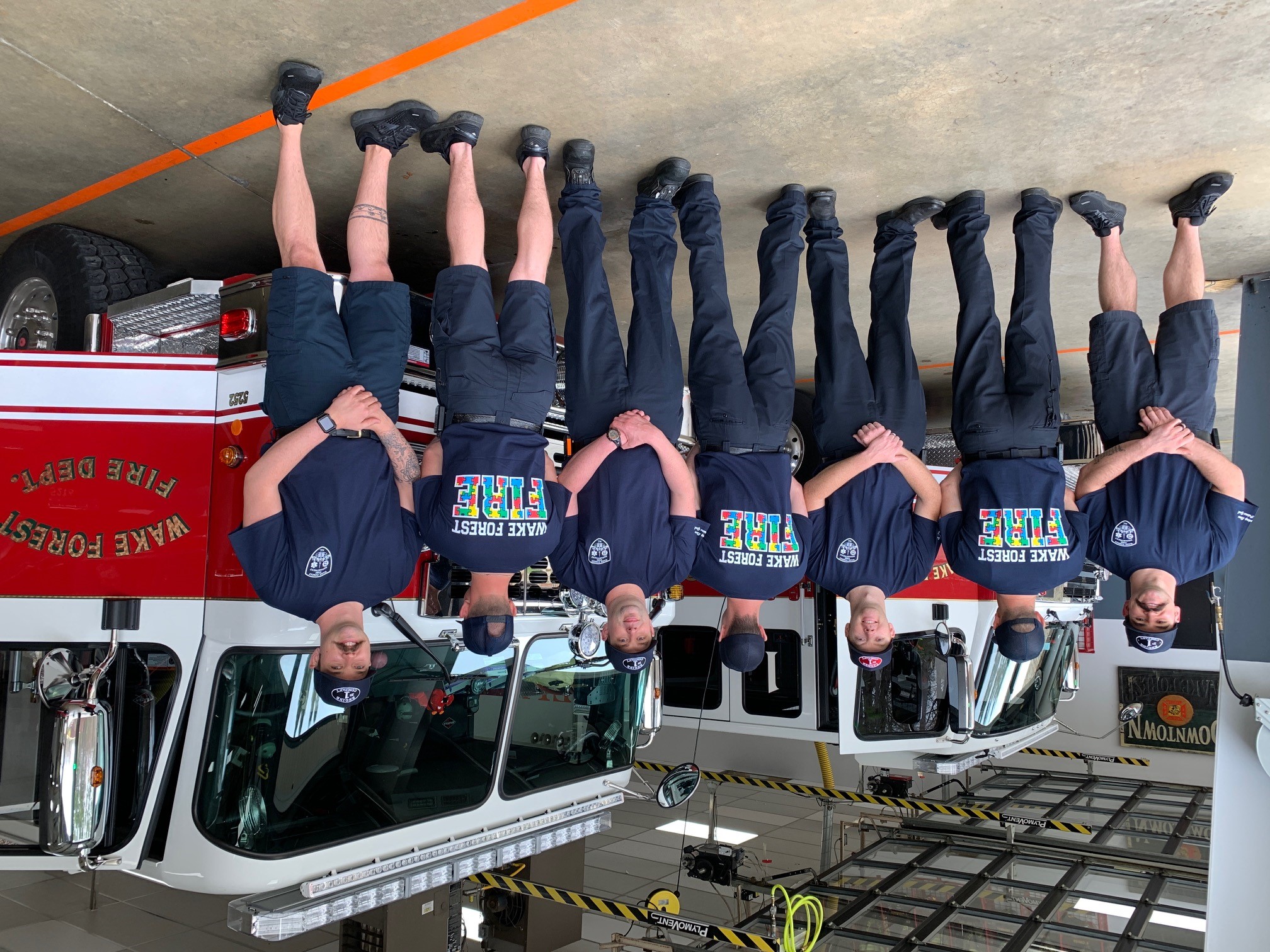
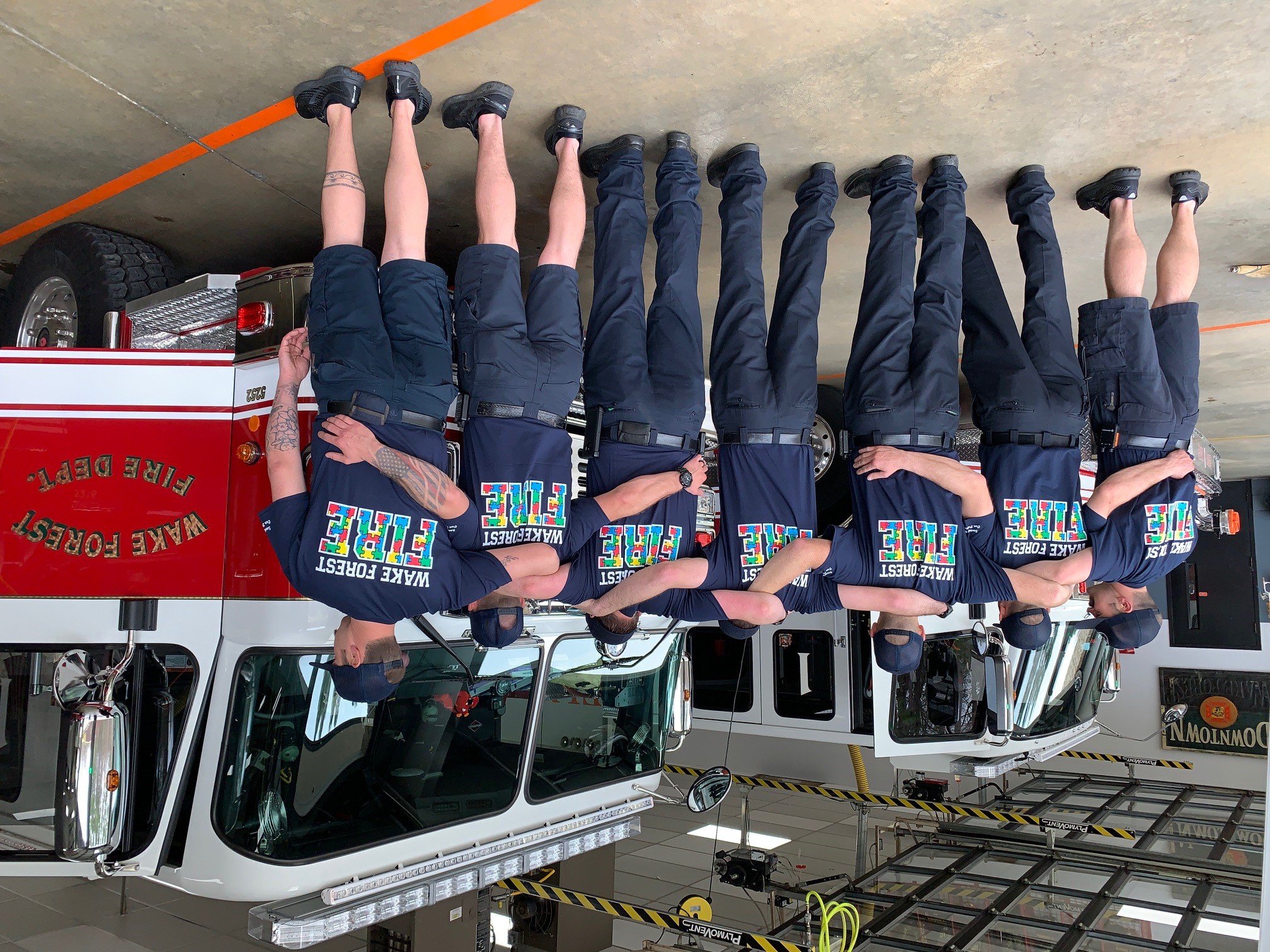
2010, Renovations at Station 1 completed. New commercial kitchen installed. Old training room is divided allowing for 3 offices to be built. One full bay is enclosed adding a museum and new training room.
2010, After several mechanical problems with Ladder 1, the department sold the mid-mount and purchased a 100' rear mount platform ladder truck built by Pierce.
2010, WFFD ran a total of 2,416 emergency calls for the year.
2011, New Ladder 1 is delivered to Station #1 and put in service. This piece is a 2011 100' rear-mount aerial platform built by Pierce. A "wet-down" ceremony is held at Station #1.
2011, After 3 years as Fire Chief, Freddy Lynn resigns and Deputy Chief Ron Early is promoted to the Rank of Fire Chief.
2011, A proclamation is signed for the merger of the Falls Fire Department and Wake Forest Fire Department. Merger is not completed for several months but the two organizations begin combining personnel and policies.
2011, To honor the 10 year anniversary of the attacks of 9-11-01, the Wake Forest Fire Department holds the third annual "Tunnel to Towers Run" in memory of FDNY firefighter Stephen Siller who perished on 9-11-01. 343 sets of boots were collected (343 in honor of the 343 FDNY firefighters killed on 9-11-01) and set at the finish line of the run. Each pair of boots had the name of a firefighter that was killed on 9/11.
2011, WFFD ran a total of 2,579 emergency calls for the year
2012, Delivery of new engine to Station #3. The new Engine #3 is a 2012 Pierce Saber. This is the first side mount pump that WFFD has ordered since switching to custom cab trucks. Former Engine #3 becomes Engine #4. Former Engine #4, a 1989 FMC, is taken out of service. A "wet-down" ceremony is held at Station #3.
2012, March 25 Falls Fire Department and Wake Forest Fire Department officially merge. The Falls fire station becomes WFFD Station #5 and the equipment assigned to it is: Engine #5, Tanker #5, Squad #5, Fire Boat #5, Utility #5 and Car #6. Station #5 is staffed with part-time employees on weekdays from 7am-5pm and then fully staffed by volunteers during night shifts and weekends.
2012, Confined Space trailer completed in Holbrook Village Training Center at Station #1. The trailer consists of three levels with various confined space obstacles including: diminishing clearances, collapsible floor, entanglement props, wall breach, and attic rafters.
2012, WFFD ran a total of 2,566 emergency calls for the year.
2013, The official Wake Forest Fire Department Flag is designed.
2013, Wake Forest Fire Department voted "Best of the Best" Community Organization by The Wake Weekly.
2013, November - New 2000 gallon elliptical tanker is delivered and put in service at Station #2. Tanker #2 is part of the Northern Wake County Tanker Strike Team.
2013, WFFD ran a total of 2,592 emergency calls in 2013
2014, Station #4 officially approved by the Town of Wake Forest, location of Station to be at 1505 Jenkins Rd
2014, For the second year in a row, WFFD is voted "Best of the Best" Community Organization by the Wake Weekly.
2014, Deputy Chief Clifton Keith is recognized for his 50 years of service to the Wake Forest Fire Department at the annual Awards Ceremony.
2014, November 3- Recruit Class 0414 hired and begins academy. 12 recruits begin academy.
2014, 24th of November- Groundbreaking Ceremony for Station #4 held.
2014, WFFD ran a total of 2,950 emergency calls in 2014.
2015, A second ladder truck is purchased to replace Rescue #3 at Station #3. This ladder is used as a reserve ladder. It is a used 1990 E-One Protector. It has a 1500 GPM pump, 300 gallons of water, and a 75' stick.
2015, With the completion of Station #4 upcoming, the need of an additional reserve engine is met with the purchase of a used engine from the City of Raleigh. The engine is a 1995 Pierce Dash with a 1250 GPM pump and 500 gallons of water. It has no designation other than "Reserve Engine."
2015, March 26- The historical Cullom House at 427 N. Main Street catches fire and burns to the ground. The 124 year old house was under renovations at the time of the fire. Crews received the call and were on scene within 4 minutes to find the house completely engulfed in flames. The house was built in 1891 and suffered a small fire in the 1970's.
2015, June 26- Recruit Class 0414 Graduates with 10 new firefighters. The graduates are: Aaron Hale, Chad Paige, Taylor Cornelius, William Windsor, Lee Blackwell, Scott Gregory, Edward Eason, Justin Mitchell, Mary Beth King, and Chris Kearney. FF Mary Beth King is the first full-time female firefighter for the Wake Forest Fire Department.
2015, July 1- Engine #4 placed into service at 0700. Station #4 located at 1505 Jenkins Road, currently under construction. Engine #4 crew responds from Station #4 district during the hours of 07:30-20:00 and then return to Station #1 for the remainder of the shift. Wake Union Baptist Church opens their Fellowship Building for Engine #4 crew to use as a temporary fire station.
2015, WFFD ran a total of 3,196 emergency calls in 2015. Breakdown per unit is as follows:
Engine #1 - 1,403
Engine #2 - 818
Engine #3 - 428
Engine #4 - 302 (Went into service on July 1, 2015)
Engine #5 - 401
Ladder #1 - 833
2016, January 22- Station #4 located at 1505 Jenkins Rd officially opens.
2016, February 14- WFFD takes delivery of the new Engine #4. Engine #4 is a 2015 Rosenbauer Commander, the first Rosenbauer fire engine for WFFD.
2016, April 3- Open House and Dedication of new Engine #4 held at Fire Station #4 on Jenkins Rd. Official "uncoupling" ceremony for station and "wet-down" of new engine takes place.
2016, Captain Edward Barrett is promoted to the rank of Battalion Chief and is assigned to A-Shift. Chief Barrett becomes the first paid Battalion Chief in WFFD History. The new Battalion Chief positions will be filled over the next three years for all three shifts. The Battalion Chiefs will serve as operational chiefs for each shift.
2016, WFFD ran a total of 3,075 emergency calls in 2016. Breakdown per unit is as follows:
Engine #1 - 1,381
Engine #2 - 884
Engine #3 - 634
Engine #4 - 759
Engine #5 - 493
Ladder #1 - 1,004
2017, February 10th - Captain Matthew Strawbridge is promoted to Battalion Chief and assigned to C-Shift. Chief Strawbridge is the second paid Battalion Chief in WFFD History.
2017, October- WFFD officially launches its UAS (Unmanned Aerial System" "Drone Program". The Drone is piloted by Steve Rhode and is used for various incidents including fires, searches for missing persons, wildfires, and hazardous materials calls. "Firebird 1" is equipped with a thermal camera to help locate missing persons and a zoom visual camera.WFFD is a leader in the United States with the use of drones in the fire service.
2017, The Wake Forest Fire Department responded to 3,787 emergency calls in 2017. The breakdown per unit is as follows:
Engine #1- 1,367
Engine #2- 852
Engine #3- 720
Engine #4- 749
Engine #5- 510
adder #1- 1,054
2018, February- Captain Jeremey Blake is promoted to Battalion Chief and assigned to B-Shift. Chief Blake is the third paid Battalion Chief in WFFD history and completes the three year process of assigning a Battalion Chief to each of the three shifts.
2018, May 10th. WFFD takes delivery of a 2018 Rosenbauer Tanker. Tanker #4, is the first custom cab Tanker in Wake County. It holds 2000 gallons of water.
2018, September 14th. For the first time ever, the WFFD Emergency Preparedness Team set up an Emergency Operations Center (EOC) for the Town of Wake Forest for the approaching Hurricane Florence. The EOC consisted of WFFD personnel, Town of Wake Forest Public Utilities Dept, WFPD, and Town of WF representatives and lasted for 48 hours. The EOC monitored emergency calls in the WF area and consolidated resources to allow for WF Power and WFFD personnel to respond together to handle power related issues. This was a major success for emergency management in the Town of Wake Forest.
2018, September 27th. Captain Reginald Rogers becomes the first career member to retire from the Wake Forest Fire Department. Captain Rogers served 21 years with the WFFD and was the first full-time African-American employee. Throughout his career he served on Engine #1, Engine #2, and retired from Engine #3.
2018, November- Official letter received from Wake Forest Fire Department Board of Directors requesting the Town initiate a study on the feasibility of integrating the Wake Forest Fire Department into the Town’s administration.
2018, WFFD ran a total of 3,996 emergency calls in 2018. Breakdown per unit is as follows:
Engine #1 - 1,420
Engine #2 - 857
Engine #3 - 756
Engine #4 - 760
Engine #5 - 544
Ladder #1 - 1,218
2019, August 28th. WFFD takes delivery of the very first Tractor Drawn Aerial (tiller) in department history. "Ladder #4" is 2007 Spartan Crimson with a 103' ladder. It was purchased used and was formerly Boise (ID) Ladder 5. This apparatus is used for training staff and will be placed into service upon completion of Academy 0919.
2019, October 1st. Formal decisions by both Boards to integrate the Wake Forest Fire Department into the Town of Wake Forest's administration. Official date of transition approved for July 1, 2020.
2019, October- Renovations begin at Station #2 in order to accommodate two fully staffed companies. Renovations expected to be completed by the Spring of 2020.
2019- WFFD ran a total of 4,105 emergency calls in 2019.
2001, Six personnel hired for 24 hour staffing. Three shifts formed consisting of a Captain and a Driver/Operator. A-Shift is Captain Erick Mohn and FF Greg Hockaday, B-Shift is Captain Reginald Rogers and FF Waylon Holbrook, and C-Shift is Captain Daryl Cash and FF Bo Medlin.
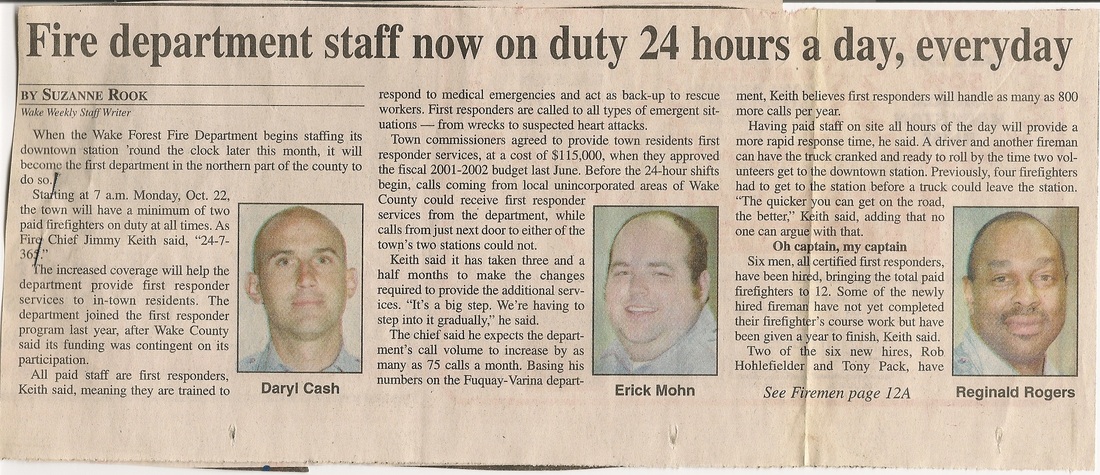
2001, Station #2 completed on Ligon Mill Rd.Building includes 800-square foot suite leased by Wake Forest Police Department as substation. (February, 2001)
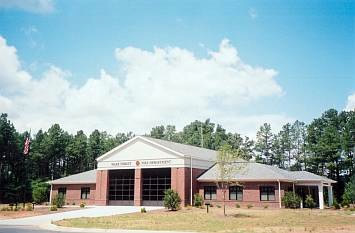
2002, After 9-11-01 the members of WFFD were inspired to raise money and donate to the FDNY Widow and Children's fund. A t-shirt was designed and sold throughout the community. In March of 2002 members of WFFD traveled to the FDNY Training Center and presented a check for $70,000.
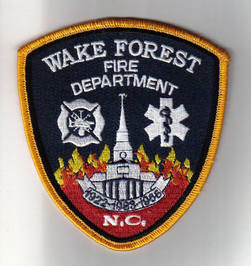
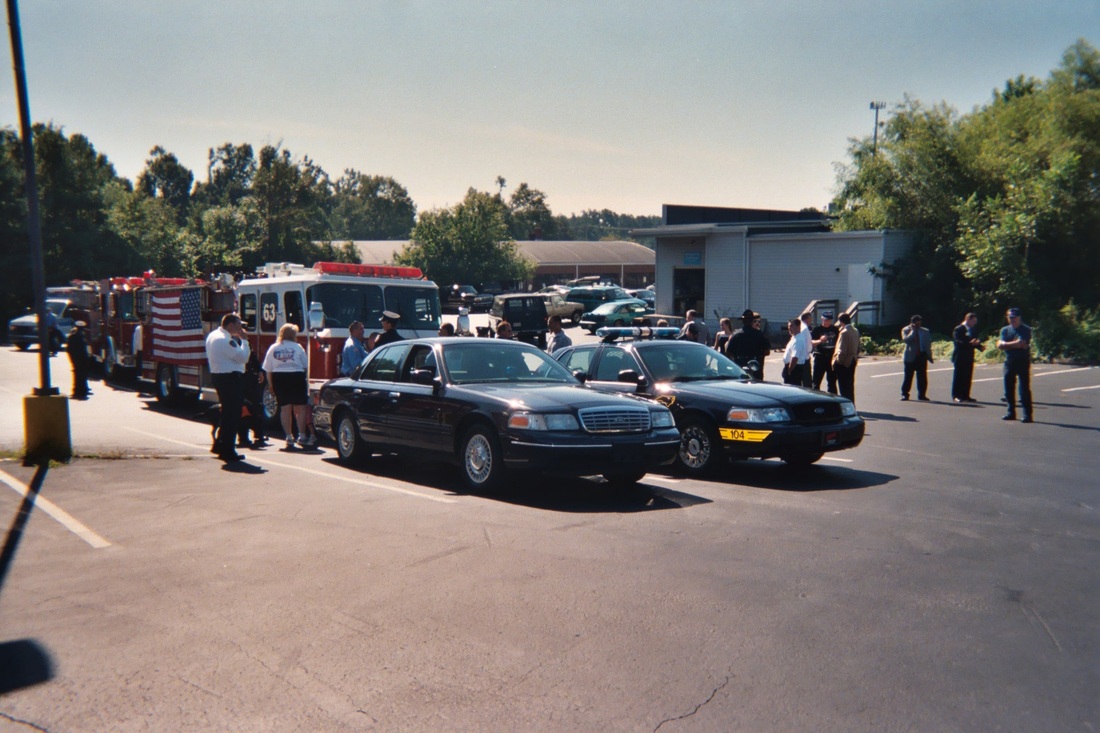
| 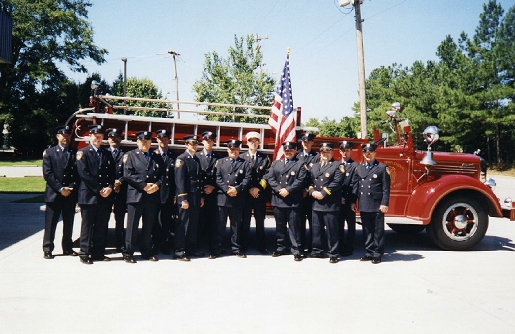
|
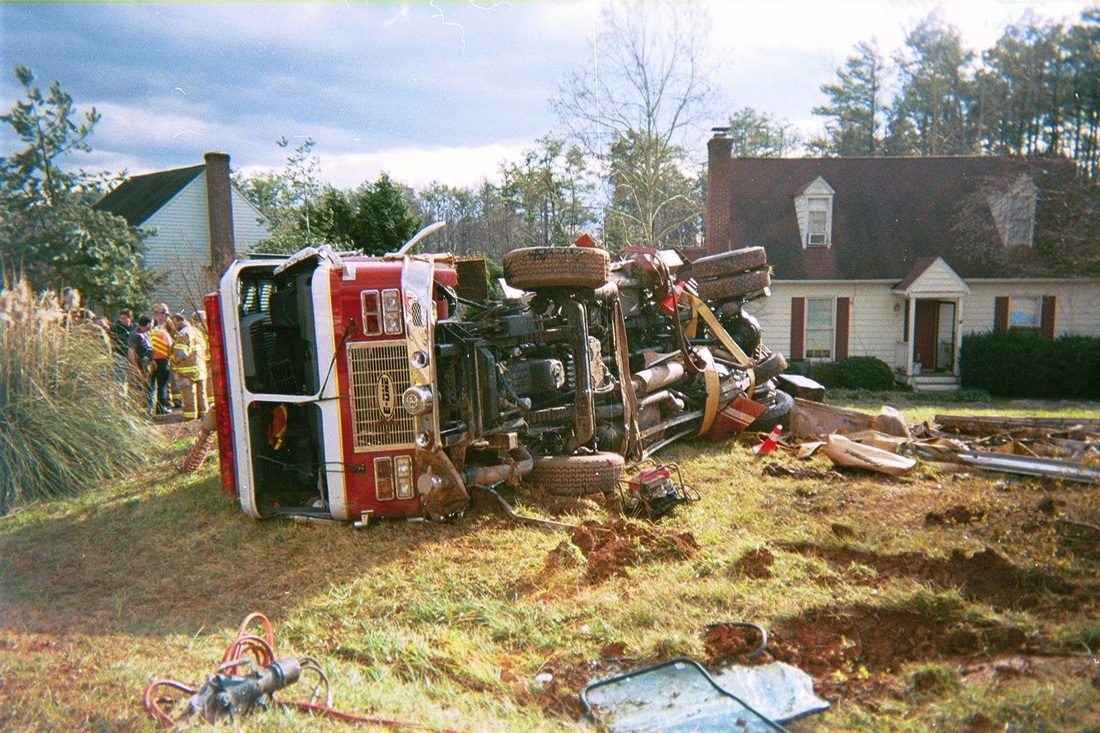
| 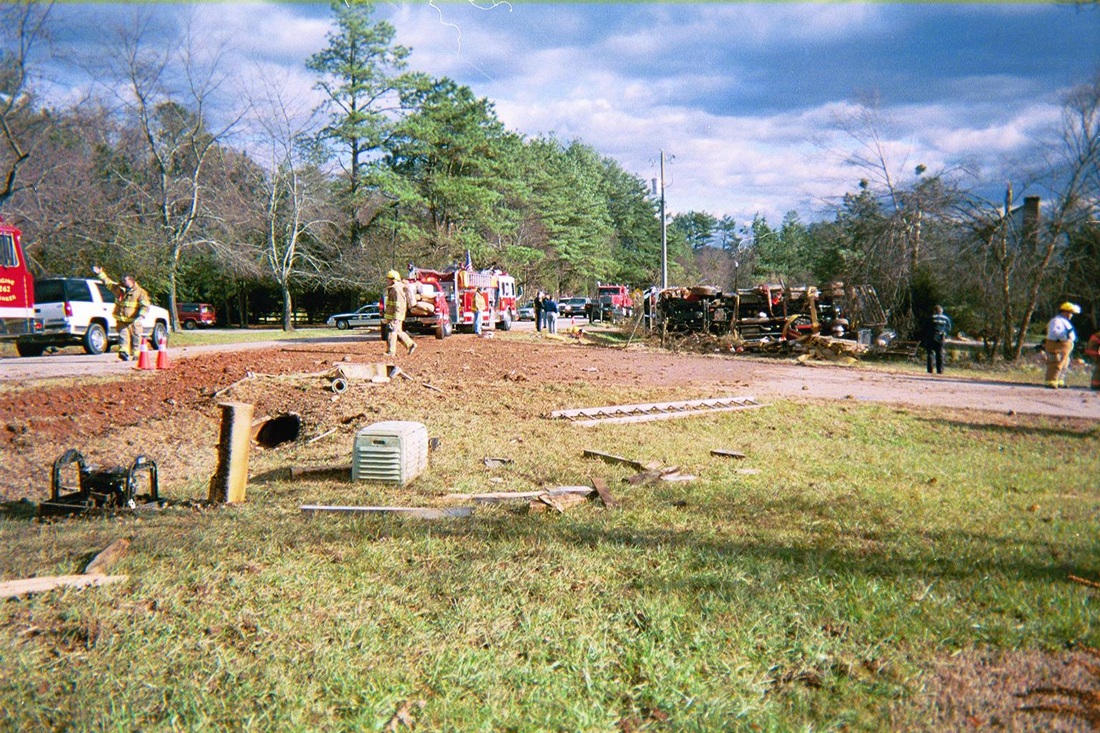
|
2003, WFFD takes delivery of a 2003 E-One. This engine has a 1000 gallon tank and 1500 GPM pump and replaces the 1996 E-One that was wrecked a year earlier on Christmas Day.
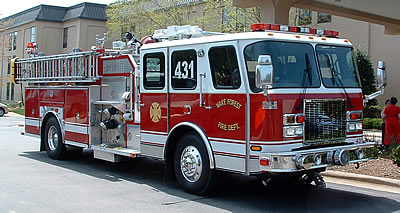
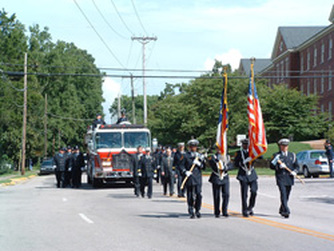
| 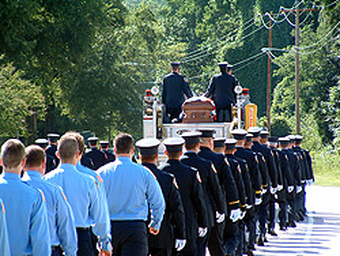
|
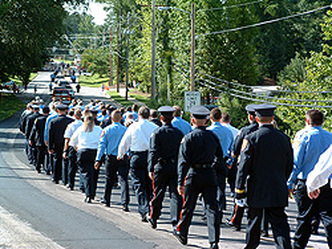
| 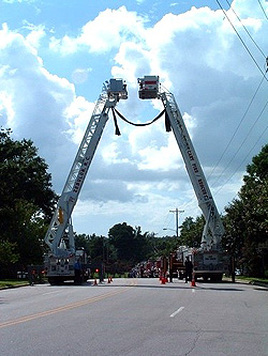
|
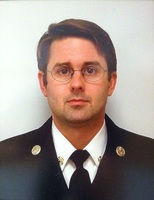
2005, Two full-time firefighters hired for 24-hour staffing bringing a total of four personnel at Station #1 and three at Station #2.
2005, Fire in a residential building at the corner of N. Allen Rd and Spring St. All 10 residents living in the 800 square foot house made it out alive.
2005, Sleeping quarter renovations completed at Station #1 that added six bedrooms and two bathrooms.
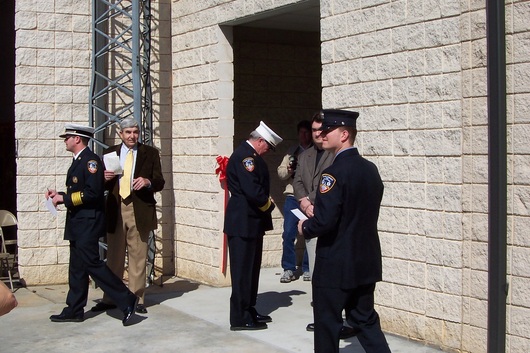
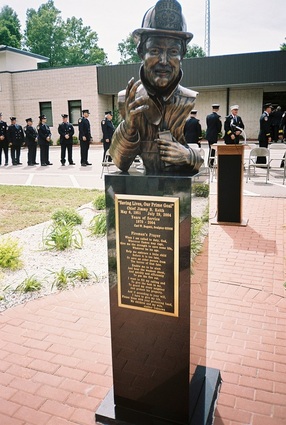
2006, A dispatched fire alarm at a residence on S. Main St turns out to be a working house fire with two elderly people trapped. Firefighters Matt Harrison and Troy Gardner make entry and successfully rescue the elderly couple. The two are recognized with the departments Silver Star Award.
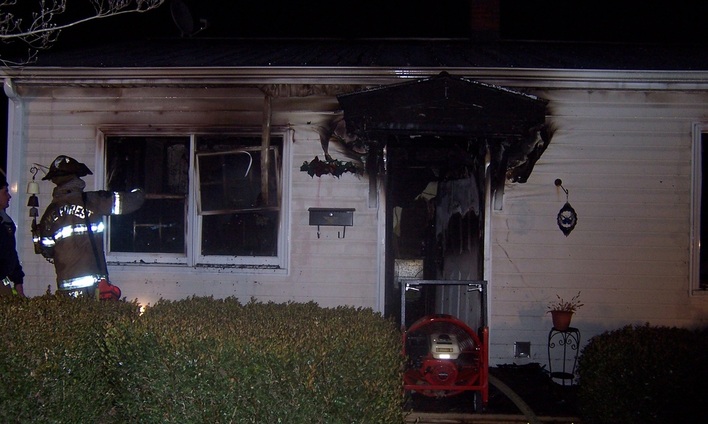
| 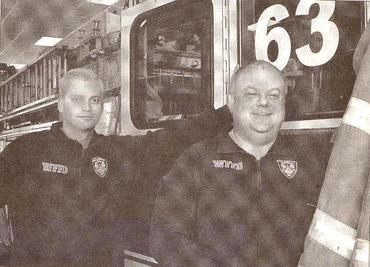
|
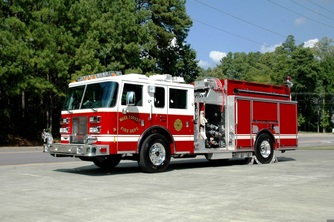
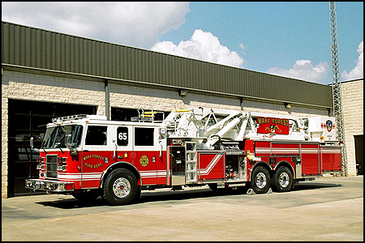
| 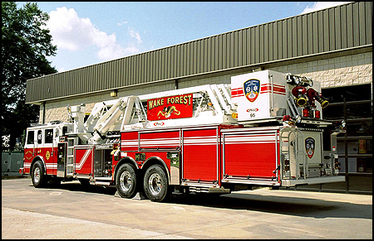
|
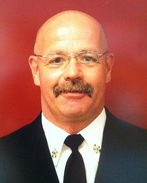
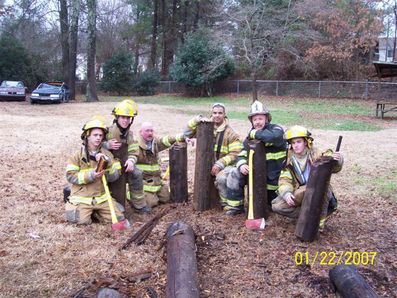
| 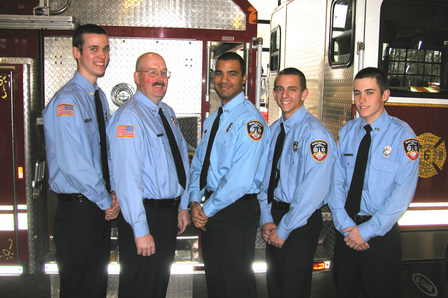
|
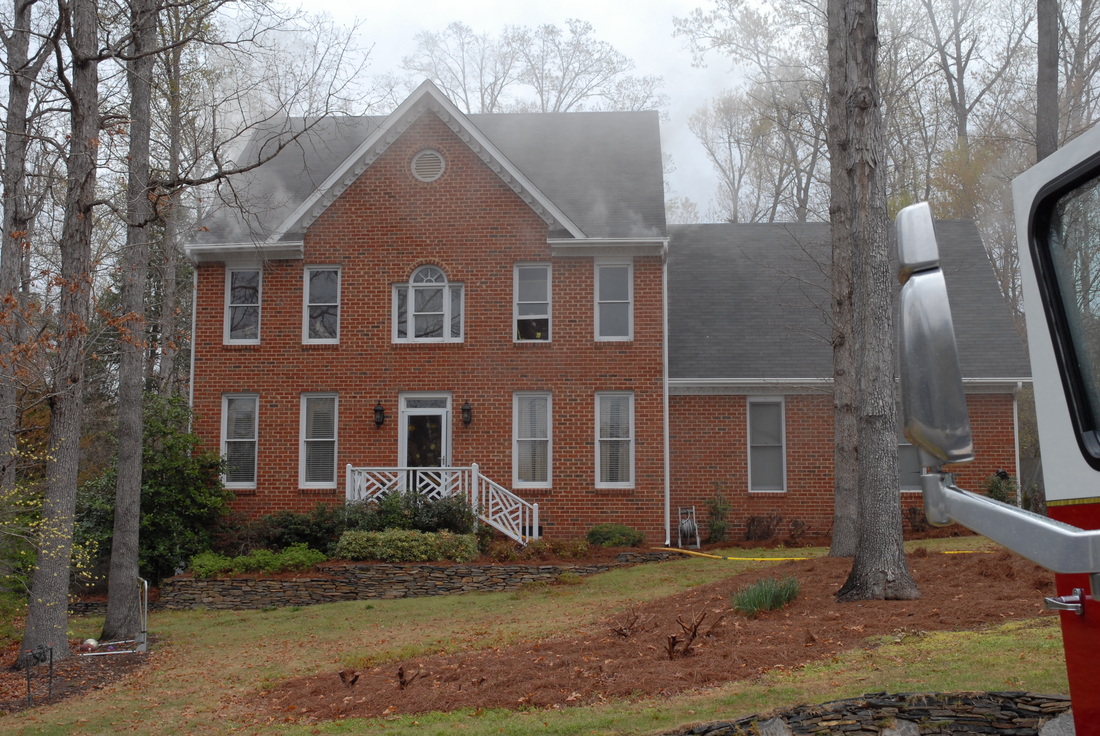
| 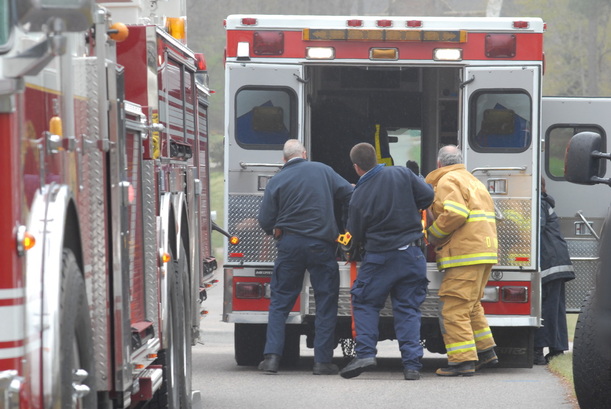
|
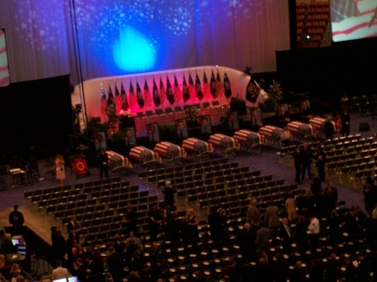
| 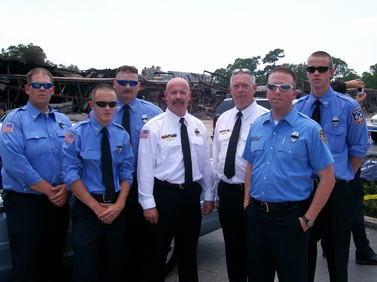
|
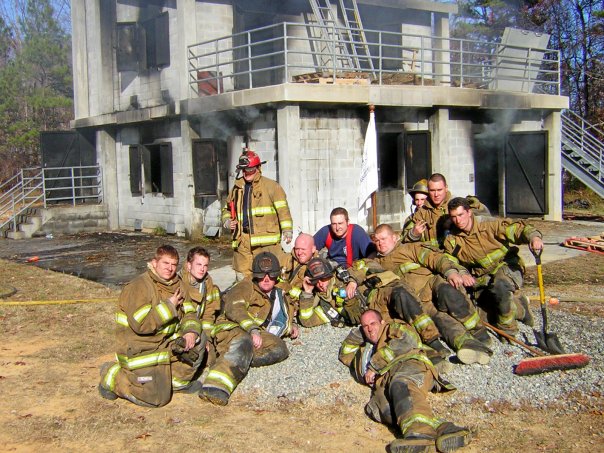
| 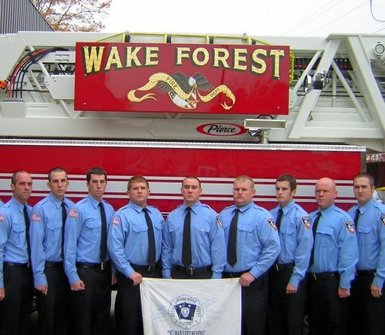
|
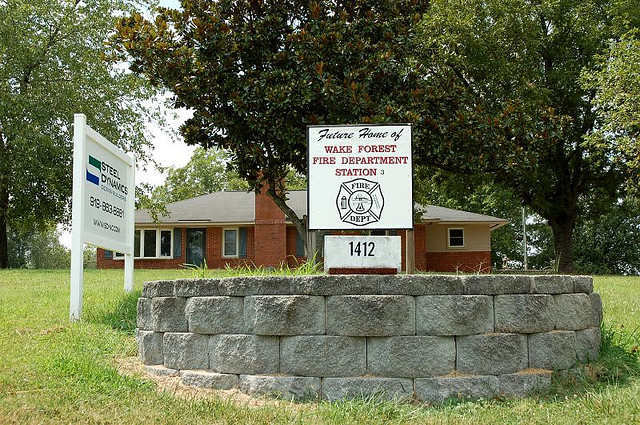
| 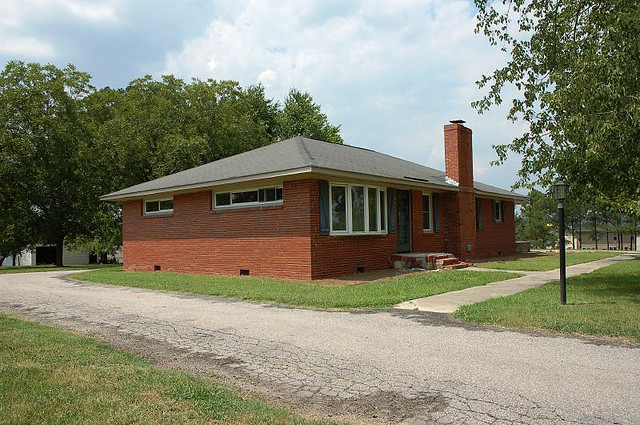
|
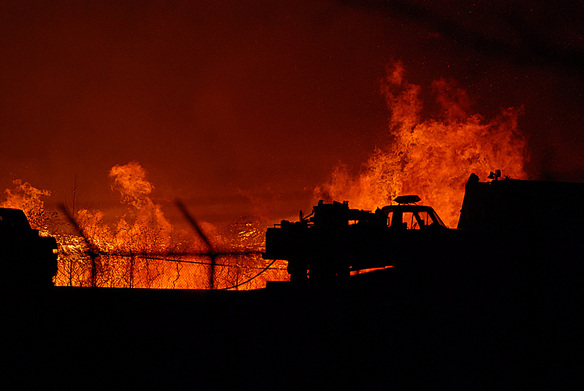
2008, In May the Wake Forest Fire Department sent an engine and a brush truck with 6 personnel to Hyde County, NC to assist the NC Forestry Service in battling the Evans Road Forest Fire. The inferno lasted over 2 months and used firefighters from all over the state. The crew from WFFD stayed a week and bunked at the local high school.
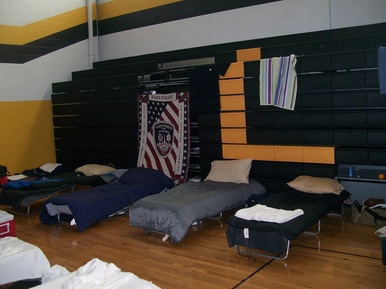
| 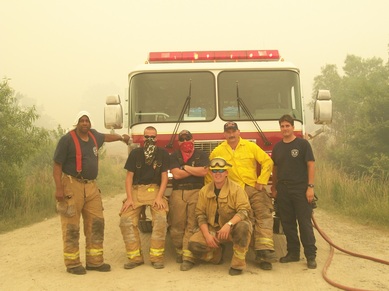
|
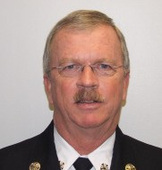
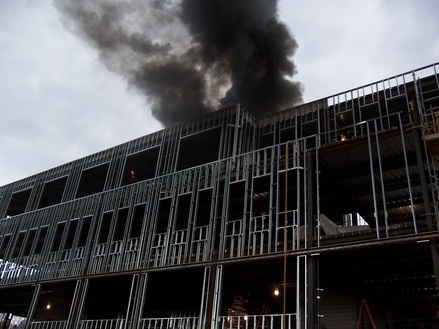
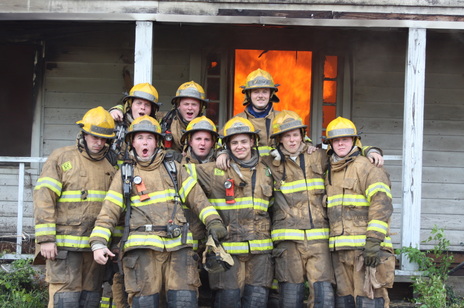
| 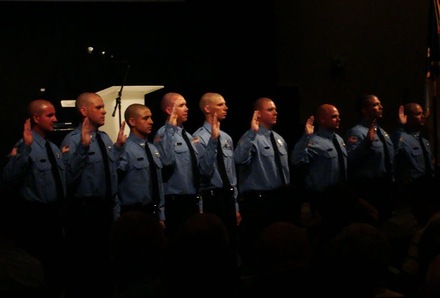
|
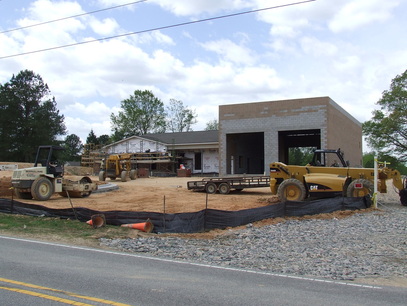
| 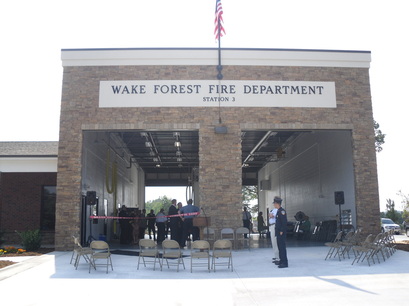
|
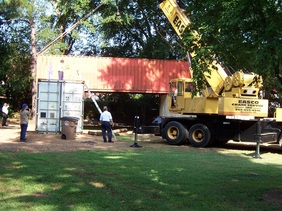
| 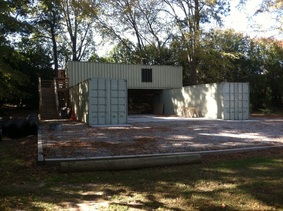
| 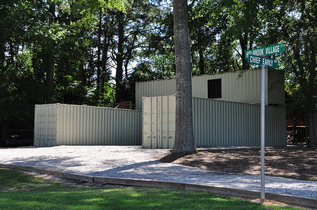
|
1993, New Freightliner Squad truck received to replace old Squad 6.
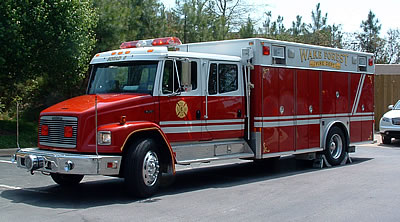
|
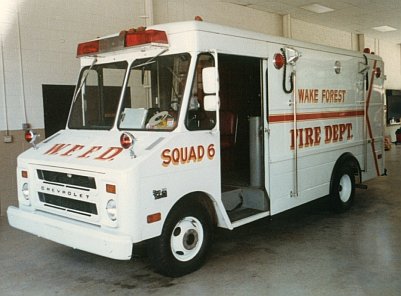 | 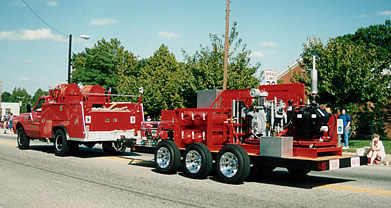 | 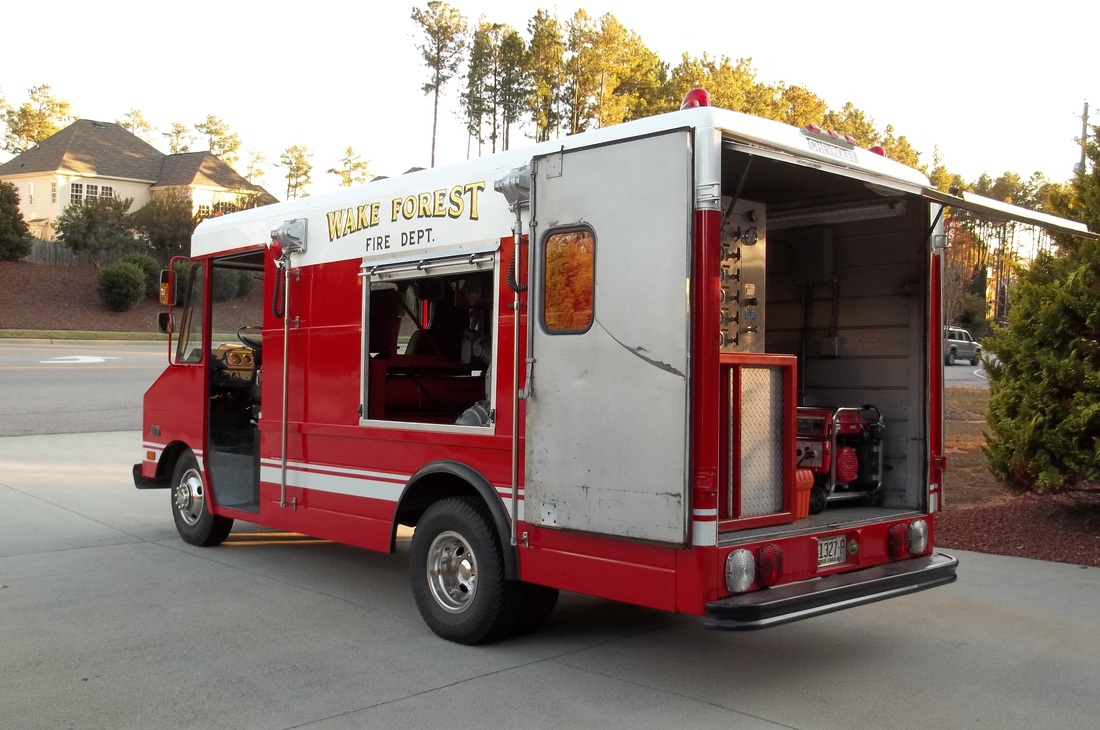 |
1996, Baptist Seminary physical plant building on Wingate Road destroyed by fire. Second oldest building on Southeastern Baptist Theological Seminary campus catches fire at 3:56 a.m. Seven-alarm fire causes nearly one million dollars damage to two-story building. Cause of blaze is leaky pipe that short-circuited electrical system, which ignited blaze. The building was erected in 1923. More than 70 firefighters battle blaze. (June 17, 1996)
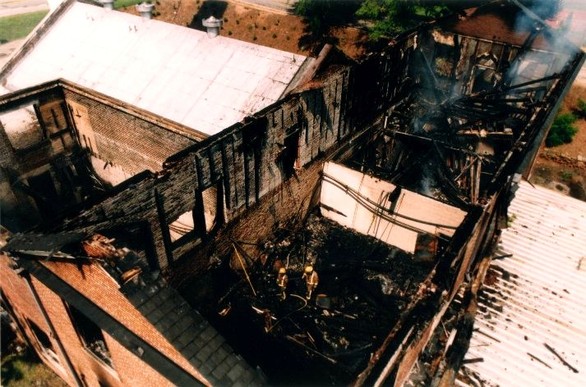
fire alarms.
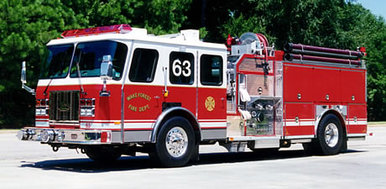
| 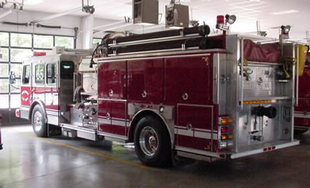
|
1997, Firefighter Reginald Rogers hired full-time to work day shift. Reginald Rogers is the first African-American full-time employee of the Wake Forest Fire Department.
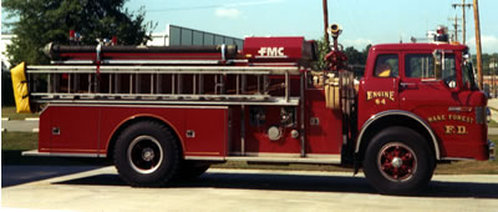
1980, fire department participates in search for missing boy. Two-year-old is later found dead from exposure, three days after wandering away from northern Wake County home. Searchers include firefighters from Stony Hill, Rolesville, and Wake Forest. More than 600 people become involved, along with tracking dogs and a helicopter.
1980, Donnie Hight named Fire Chief
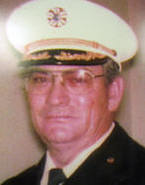
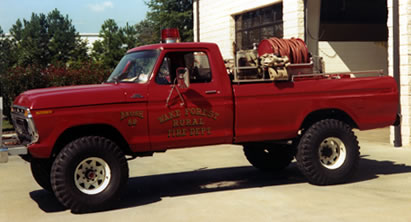
1981, explosion and fire cause $200,000 damage at North Star Chrysler-Plymouth building on US1 late in afternoon. Four departments respond-- New Hope, Wake Forest, Falls, and Rolesville. Explosion occurs about 5 p.m. Workers hear sound "like a sonic boom," go to rear of building, and discover flames from the furnace area. No new cars are damaged, thanks to passers-by who stop to help move the automobiles away from the fire. (July 2, 1981)
1981, rural fire department proposes providing fire protection for town on contract basis. Impetus is that rural department stands to lose large parts of tax base as town annexes area. According to figures in an annexation study, the rural fire district would lose about $30 million in tax base when the Town annexes south to Chappell Ford. Additional. another $10 to $15 million in tax base will be lost when the town annexes to the West. Fire Chief Donnie Hight makes presentation to Town Board, noting both Town and rural fire stations sit side-by-side and that the same chief and personnel serve both departments. (August 13, 1981)
1981, firefighters and Town officials begin discussions on contract, cost, service, and merger issues, per Chief Hight's August 13th proposal. (August 31, 1981)
1981, firefighters and Town officials agree to combine fire departments, to merge the rural and Town fire districts governed by a board of directors with equal representation from both rural and Town areas. Both areas will contribute to the fire budget based on their proportional shares of the tax base. In recent inventory of equipment, apart from the buildings, both departments are about equal. At present replacement value, Town fire department has $152,000 worth of equipment and the rural fire department has $130,000 worth. Benefits from the proposed merger include the ability of the merged department to fight fires from the Franklin County line to the Neuse River and greater water availability with quick-dump tankers, in lieu of the Town's poor water pressure.
1981, Wake Forest Fire Company #2, in operation since1942, officially merges with Wake Forest Fire Department and closes it station on Taylor St.
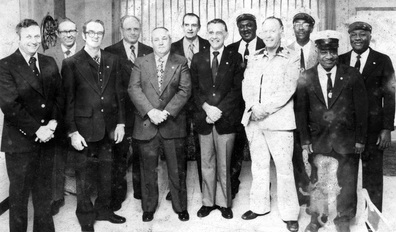
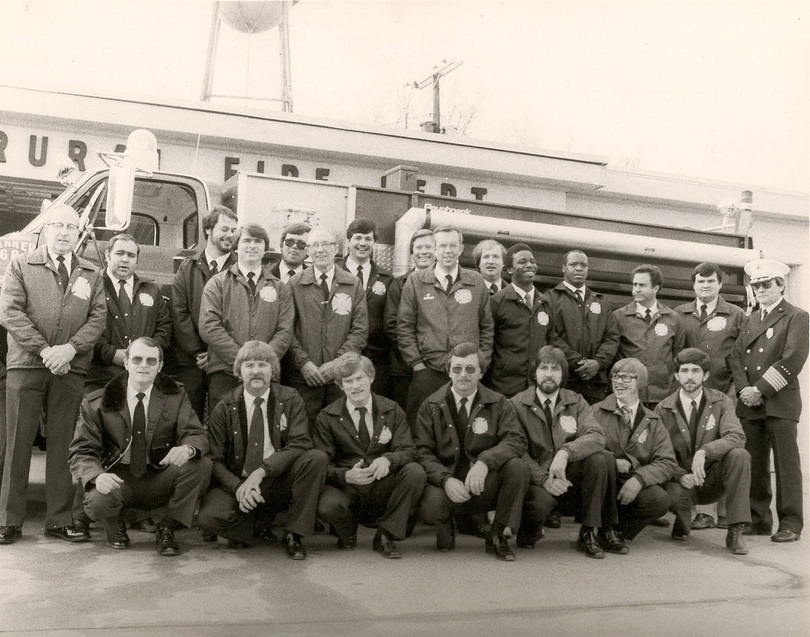
1982, apparatus dedication: 1981 FMC / Slagle tanker, 1,500 gallons. Cost $56,000. Delivered to rural department. It is named Tanker 68 (February 28, 1982)
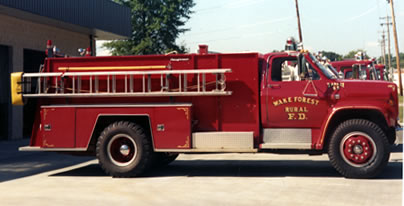
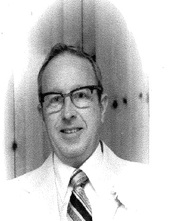
1982, Lewis B. Nuckles Award created and awarded to the fireman of the year. The inaugural winner is Hubert Denton.
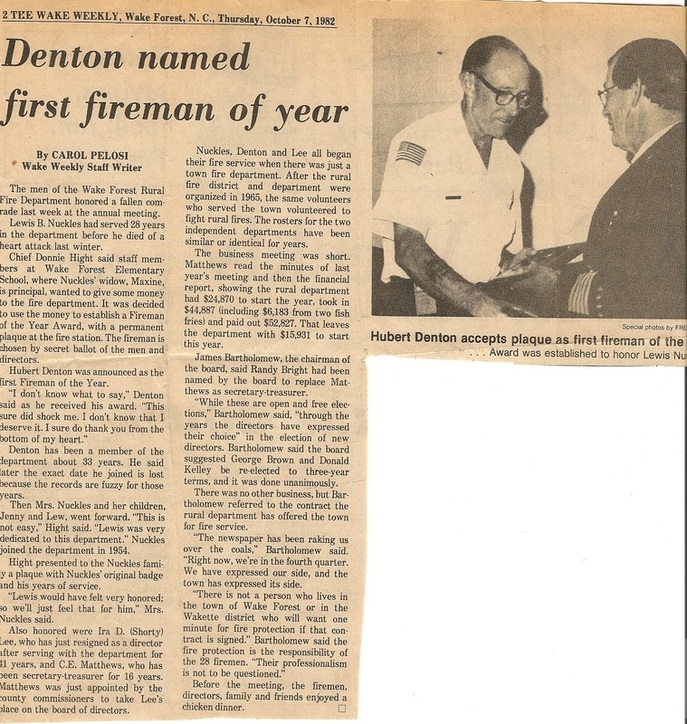
1982, Town board discusses rural fire department proposal, but disagrees with proposed restructure of governing board.. Members set September 2 for another workshop meeting. (August 12, 1982)
1982, Town Administrator reports to Town Board that the costs of fire protection would be shifted to town taxpayers under the proposed rural department plan. Because of the cost shift, he recommends against any contract or consolidation unless there is a sharper definition of the fire service to be provided. (September 1982)
1983, former fire station on Taylor Street burns. Someone is seen running from the building just before the fire is discovered, having apparently started inside the building against an inside wall. The evening blaze is discovered at 9:29 p.m. Twenty-six firefighters use 1,200 gallons of water. Fire is contained before destroying the building, though the former quarters of Wake Forest's second municipal fire department is declared a total loss. (February 2, 1983)
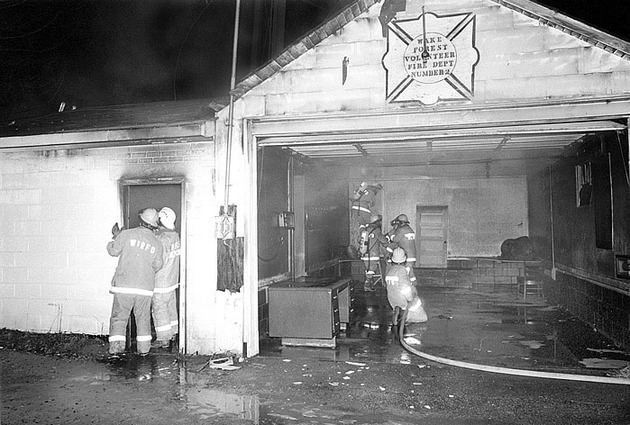
1983, town and rural fire departments merge. Wake Forest and Wakette fire districts are merged. Wake Forest Fire Department Incorporated is chartered. Town became first municipality in state to contract fire protection to another agency. Contract race is $0.05 cents per $100 valuation and department receives $24,000 for
1983, land for new fire station purchased on Elm Ave.
1984, Rolesville Market and Supply Company burns. Fire is spotted by passing motorist and believed started by someone climbing upon roof and pouring petroleum substance through bathroom vent and igniting it. One firefighter is slightly injured when Assistant Fire Chief Jimmy Keith is hit by a passing car. His leg is bruised. (February 27, 1984)
1984, ladies auxiliary formed to help firemen by providing food and drinks at major fires and assisting with fund raising. (July 1984)
1984, fire department insurance classification rating lowered to Class 5. Previously, the Town was rated Class 8 and the rural district Class 9AA/9A. (July 1984)
1984, sulfuric acid leaks from railroad car near crossing with Holden Farm Road. One employee of Seaboard Railroad is burned by the acid but not seriously injured. Spill occurs about 7:15 a.m. (November 24, 1984)
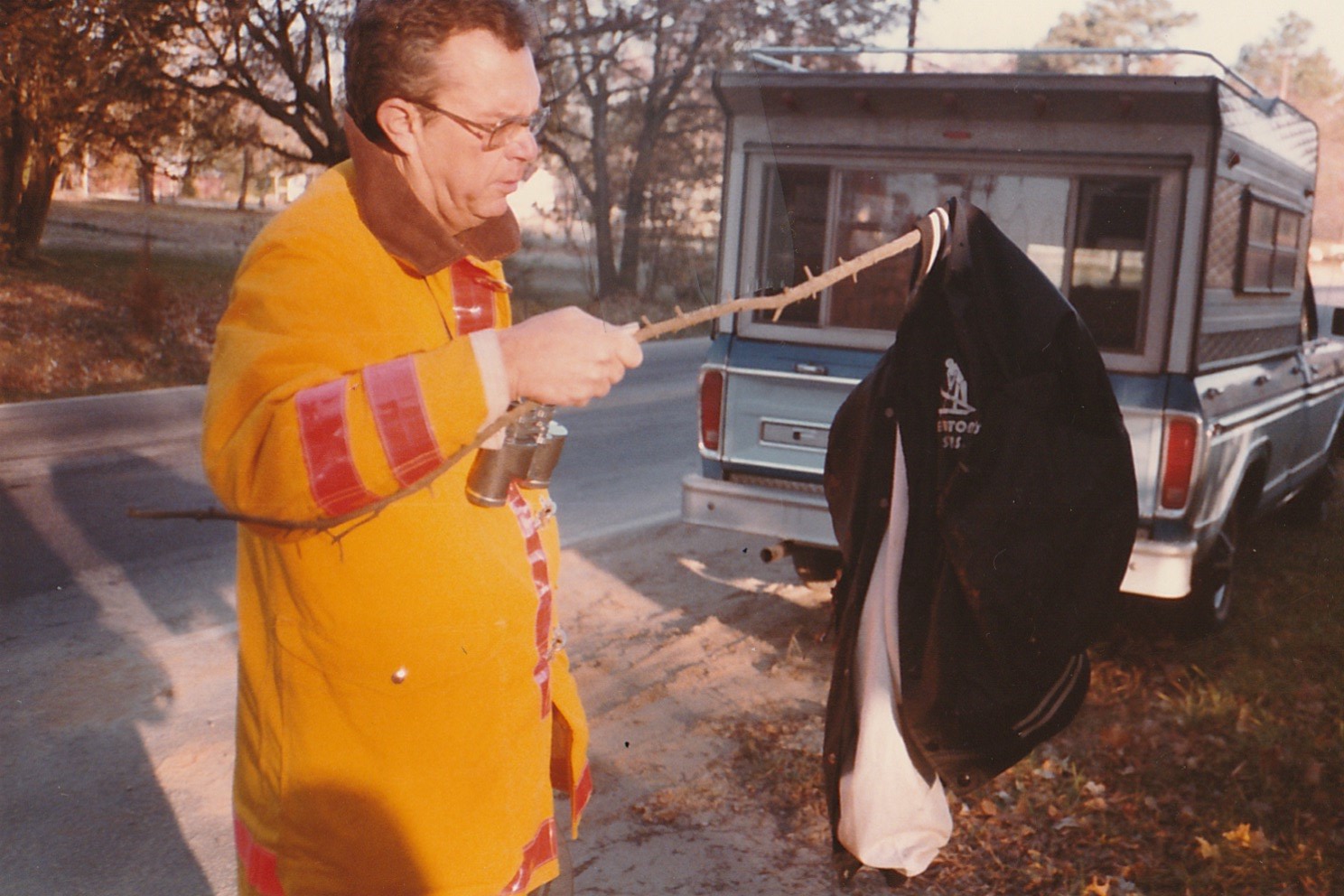
1984, one-car accident on section of old NC 98 near Falls Lake traps driver for 13 hours. Accident occurs on dead-end road, when driver gets lost looking for Interstate 85 and drives through barriers marking the end of the road and into a dirt embankment. His 1977 Volkswagen flips over upon hitting the embankment. Accident occurs about 10 p.m. and driver is found about 11 a.m. the next day when an Army Corps of Engineer employee at Falls Lake spots the car. (November 26, 1984)
1985, fire department assists Franklin County with woods fire. Blaze destroys between 200 to 400 acres from SR 1108 southeast to SR1111. Firefighters from ten departments fight fire which starts at about 11:30 a.m. Youngsville is initially dispatched and later assisted by Franklinton, Bunn, Mitchiner's Crossroads, Wake Forest, Rolesville, Louisburg, Justice, Pilot, and Centerville. Stony Hill stands by at Franklinton fire station. Two Forestry Service tractors are utilized, as are several more privately owned bulldozers. Residents of Loop Road and US 401 are evacuated. Fire is brought under control by 6 p.m. (March 12, 1985)
1985, junior firefighter division started for 16 to 18 year-olds. (August, 1985)
1985, groundbreaking ceremony held for new fire station. Construction expected to take about 180 days. Cost is around $450,000. (November 10, 1985)
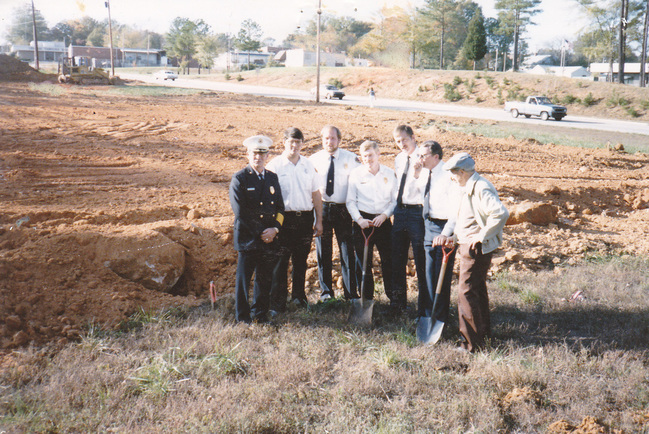
1986, old fire station placed for sale. Sealed bids with a minimum of $160,000 to be opened on February 28, 1986
1986, new fire station completed at 420 E. Elm Street. (May 1986)
1986, fire station dedicated. Ceremony starts at 2:30 p.m. (June 22, 1986)

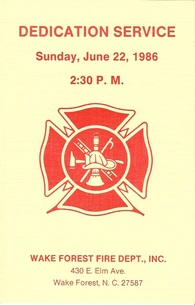
| 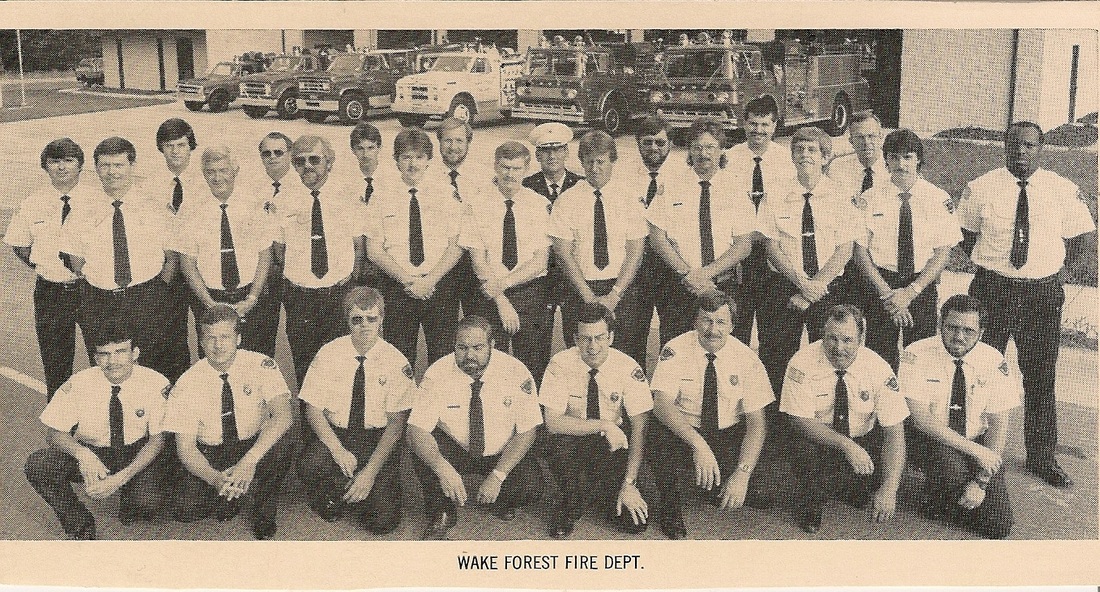
|
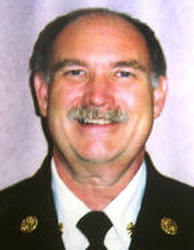
| 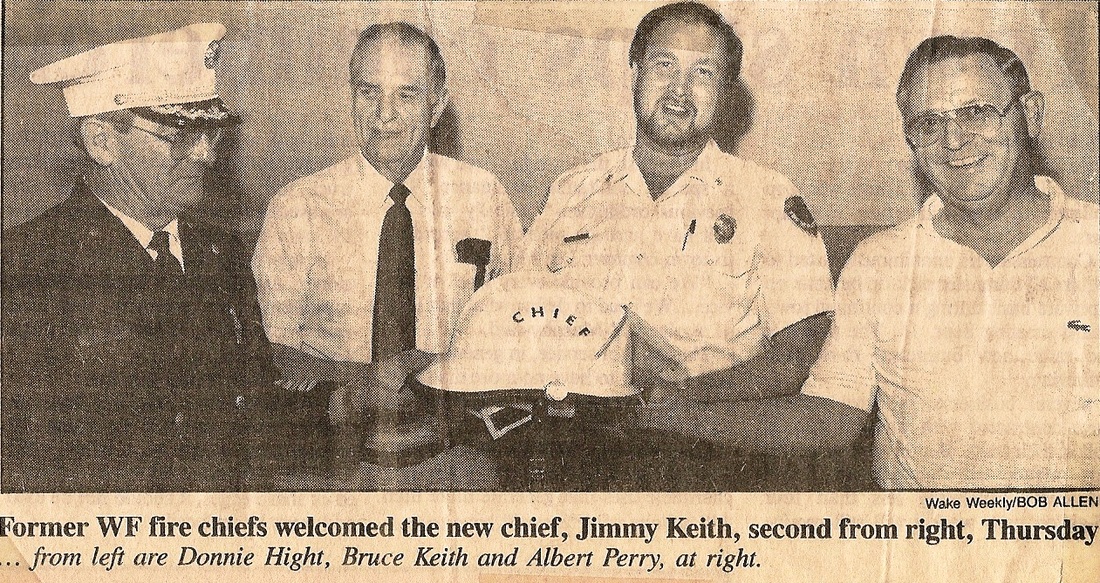
|
1989, apparatus delivery: FMC pumper, placed in service as Engine 61. (Spring 1989)
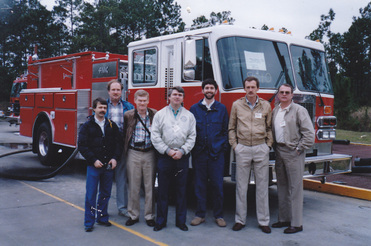
1972, apparatus delivery: 1973 Bean pumper equipped with high-pressure fog, purchased by Southeastern Seminary and given to Town . It is named Engine 63 (February 1972)
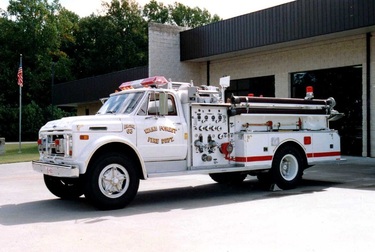
1973, Stewarts Cafe, Linda's Hair Stylin' Shop, and the Masonic Lodge Hall in downtown Youngsville burn. Fire department assists Youngsville and Forestville at 8:55 p.m. fire. (May 1973)
1973, Town fire department moves into leased service station on 300 block of South White St., next to rural fire station. Building is renovated by firefighters who clear inside of building and install four new bay doors. (April 1973) ww
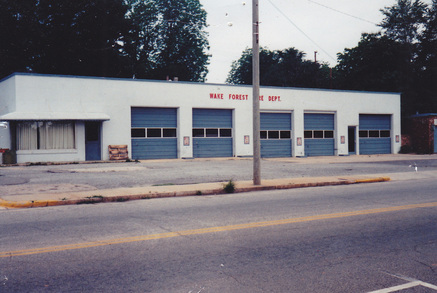
1974, Amtrak train detrains on curve behind Athey Products plant at about 8 p.m., minutes after passing through Wake Forest Eight cars of the Silver Star, traveling from New York to Miami, jump the track, injuring 28 of 270 passengers. Rescue squads respond from Wake Forest, Youngsville, Franklinton, Bunn, Zebulon, Louisburg, Cary, New Hope, as well as ambulances from Raleigh and Wake Forest. Only one of the injured passengers is hospitalized. The cause of the derailment is not immediately known. (August 1974)
1975, freight train caboose catches fire. Seaboard Coast Line train stops behind Howard Mangum's house on US1A. Fire spreads to adjoining freight car. (November 1, 1975)
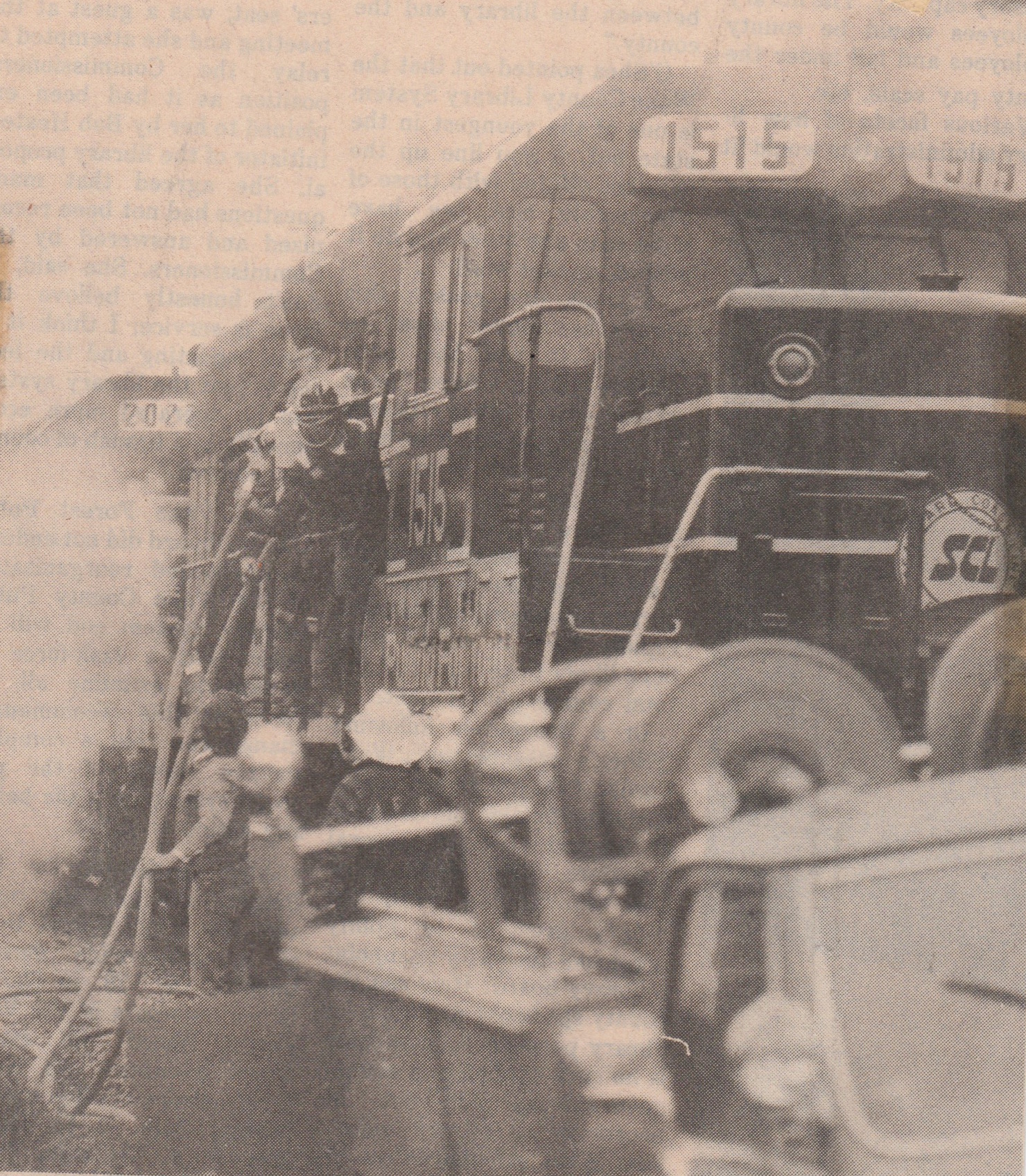
1976, home economics building at Wake Forest-Rolesville Junior High School destroyed by fire. Interior damage estimated at $10,000. Falls and Wake Forest fire departments spend two and a half hours battling blaze. (May 6, 1976)
1977, fire department purchases 25 pagers. Each Motorola unit, including pager, charger, and amplifier, costs $285.00. Firefighters use money from fundraising projects to purchase pagers. Wake County matching grant program provides 35 percent of the funds. Firefighters are currently alerted using special phone system in which a single phone call made at police station reaches 36 firefighters simultaneously. (November 1977)
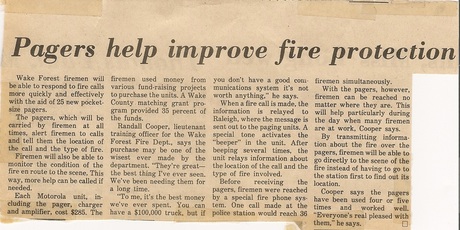 | 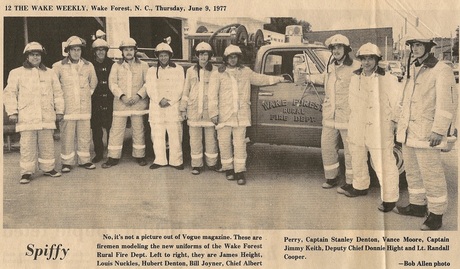 |
1978, Bruce Keith appointed acting Fire Chief of Rural department. (September 1, 1978)
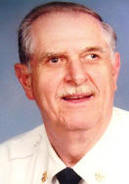
1978, Jerry Carter elected Fire Chief of Rural fire department. (October 23, 1978)
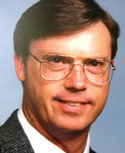
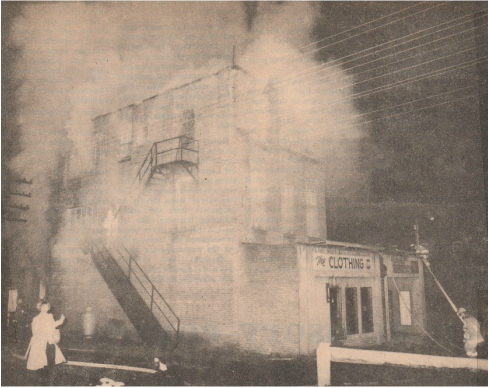
1978, fire alarm siren discontinued.
1979, Sanctuary of Oak Grove Baptist church just north of Franklin County line burns. Eleven rural fire departments and 125-150 firemen on scene.
1979 apparatus delivery: FMC / Bean pumper, 1000 GPM, 750 gallons delivered to Rural department. Replaces 1964 pumper. It is named Engine 61 (February 12, 1979)
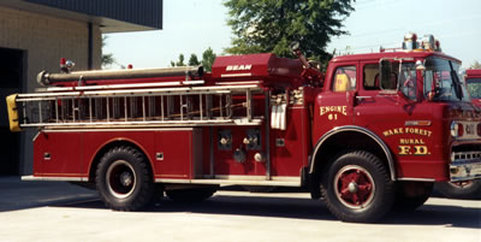

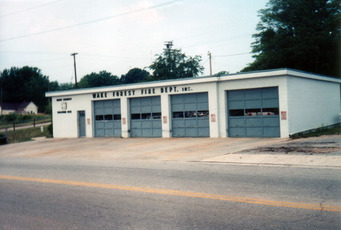
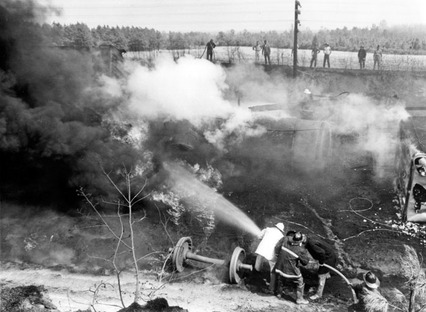
| 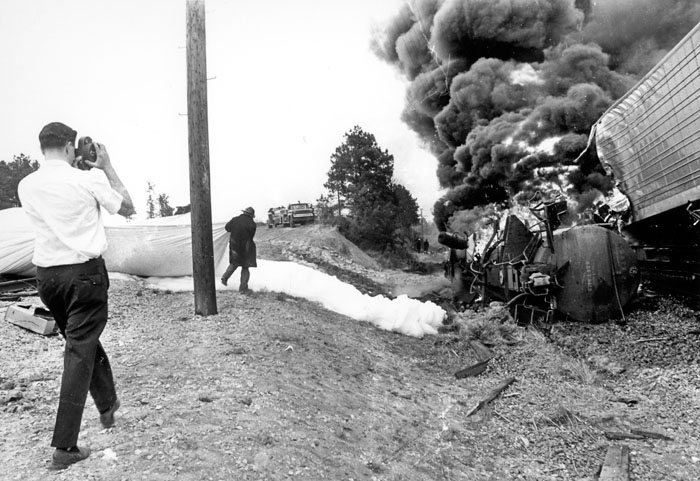
|
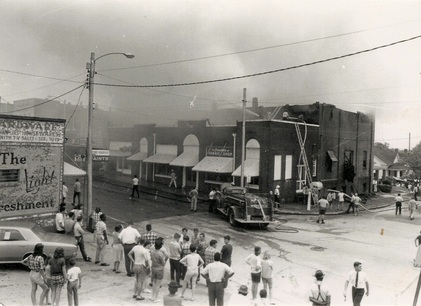
| 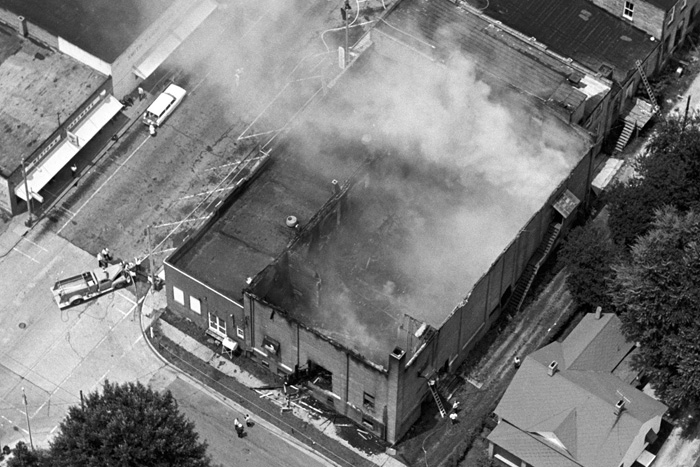 | 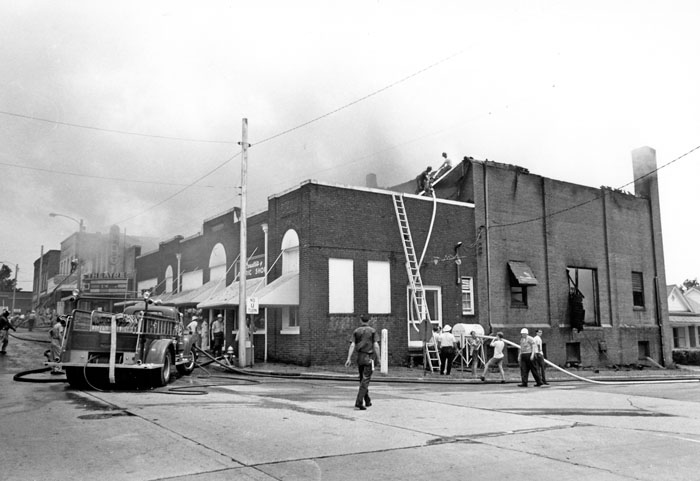
|
1968, apparatus delivery: 1968 Chevrolet Tanker with a 1200 gallon tank. Its named Tanker 67
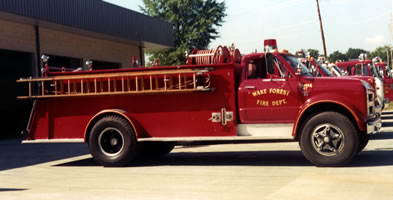
1969, apparatus delivery: Chevrolet brush truck, 200 gallons, 350 GPM. Cost about $10,000.
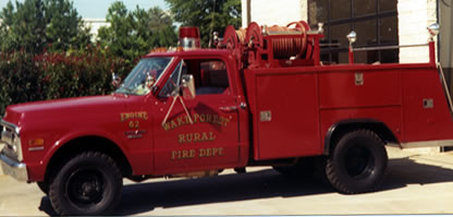
1956, first fire truck for rural department is 1942 Chevy 1 1/2 ton pumper purchased as Civil Defense surplus for $100.
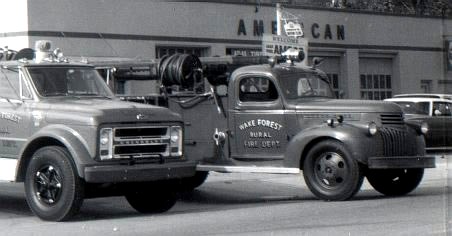
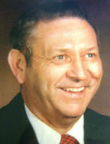

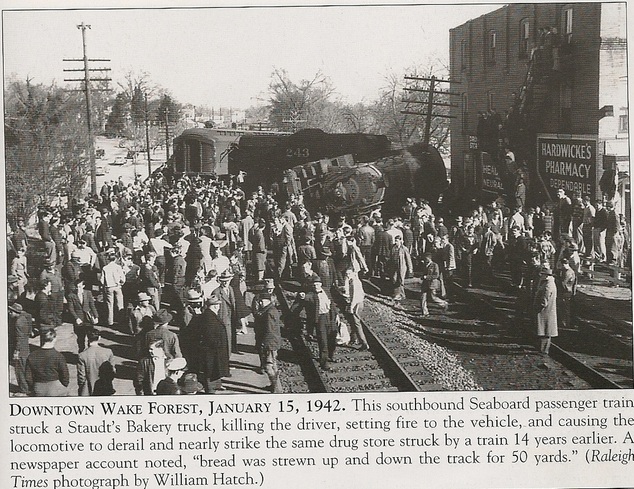
1942, Town Board appoints committee to investigate "advisability of encouraging the formation of a Colored Volunteer Fire Company". (May 7, 1942)
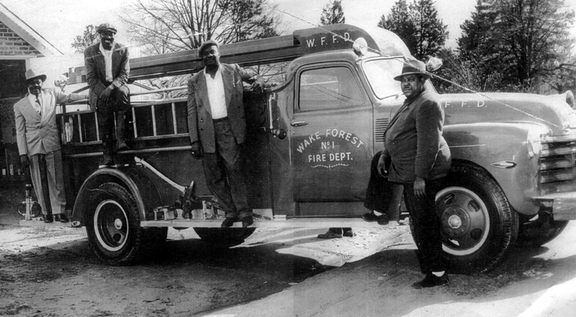
1942, Town Board orders Captain of Public Works to build shed to house fire hose on town property near water tank on east side of railroad tracks. (June 4, 1942)
1942, Town Board votes to appropriate $80 for two firemen to attend the State Firemen's Convention in Greensboro and $10 for two firemen to attend the Colored Firemen's State Convention in Warrenton. (August 6, 1942)
1942, Town Board appoints committee to investigate and act upon payment of $1.75 each for 15 members of Colored Fire Company to state association for membership and insurance. (September 3, 1942)
1943, Town Board appoints committee to purchase fire truck for Colored Fire Company. (April 1, 1943)
1943, Town Board directs Fire Chief to have "Colored Fireman's truck" started and inspected each day and to ensure that the truck is kept in good condition. The annual sum of $60.00 is allocated for this task. (August 5, 1943)
1944, Town Board orders
- four tires for Fire Truck #2
- fifty-cent registration fee for each 14 members of Fire Company #2
- colored firemen be paid on same basis as white firemen. (July 6, 1944)
1944, proposed fire department budget. (September 29, 1944):
1942-43 1943-44 1944-45 Wages of Fireman $237.75 $536.25 $550.00 Supplies 568.28 86.18 800.00 Convention & Fire School Expenses 67.28 38.84 100.00 Per Capita Tax 41.25 24.00 40.00 Servicing Colored Fire Truck 82.13 100.00 Salary of Service Man 50.00 60.00 1945, Town Board appoints committee to have Fire Truck #2 converted / repaired. (July 5, 1945) tm
1946, Sanborn Fire Insurance map update dated January 1946 updates prior map information with"
- 22 men
- 2 stations
- Barton pump capacity of 500 GPM
- Gamewell fire alarm system of 19 boxes
- Also colored volunteer fire department, 12 men, and Chevrolet truck with 800' 2 1/2" hose.
Map shows fire truck storage building on lot behind drugstore on south side of Main Street, west of Cross Street. [ First location of Station 2 ? ]
1946, Town Board votes to permit Fire Company #2 to sponsor a carnival for fund-raising. Town to provide electricity, provided a suitable transformer can be obtained. (August 1, 1946)
1947, Town Board orders fire box placed near home of Mrs. L.T. Wilson. Board also orders that when Fire Truck #1 leaves town, Fire Truck #2 proceed immediately to municipal building for local calls until return of Fire Truck #1. (May 1, 1947)
1948, apparatus delivery: 1947 Chevrolet / American / Barton pumper purchased by Town.
Rent $180.00 Supplies $25.00 Fire Calls $180.00 Firemen exempt poll tax $44.00 Firemen exempt street tax $66.00 Truck Keeper 24.00 1930, contract awarded for construction of municipal building at corner of Brooks and Owen streets. Basement includes garage for fire department. (August 8, 1930)


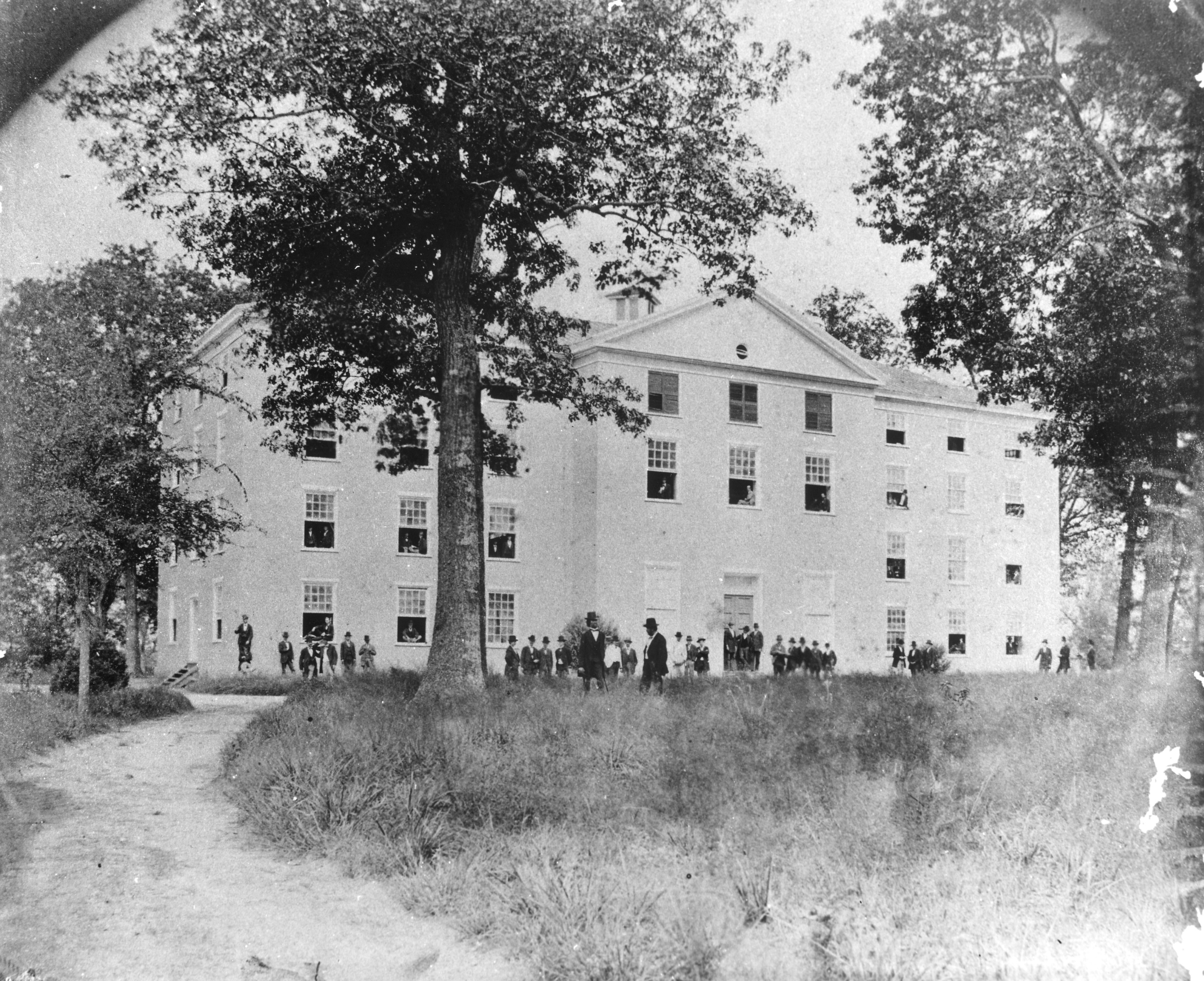 |  | 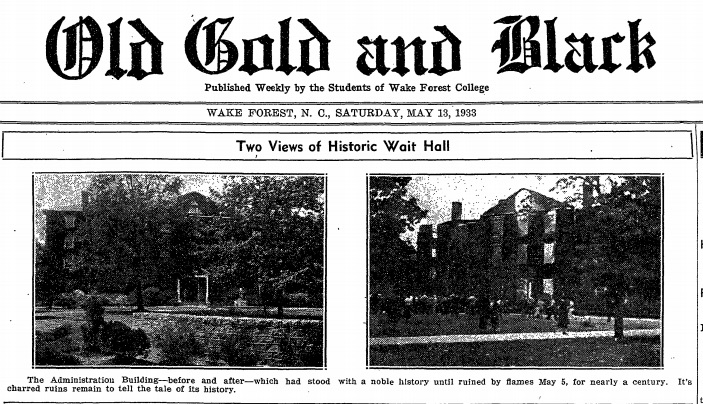 |
1933, high school building destroyed by fire. Fire starts shortly before midnight. Loss is estimated at $60,000. Blaze is well beyond control when discovered. Efforts of local firefighters are futile. The building was believed locked and unoccupied at the time of the fire.. (May 31, 1933)
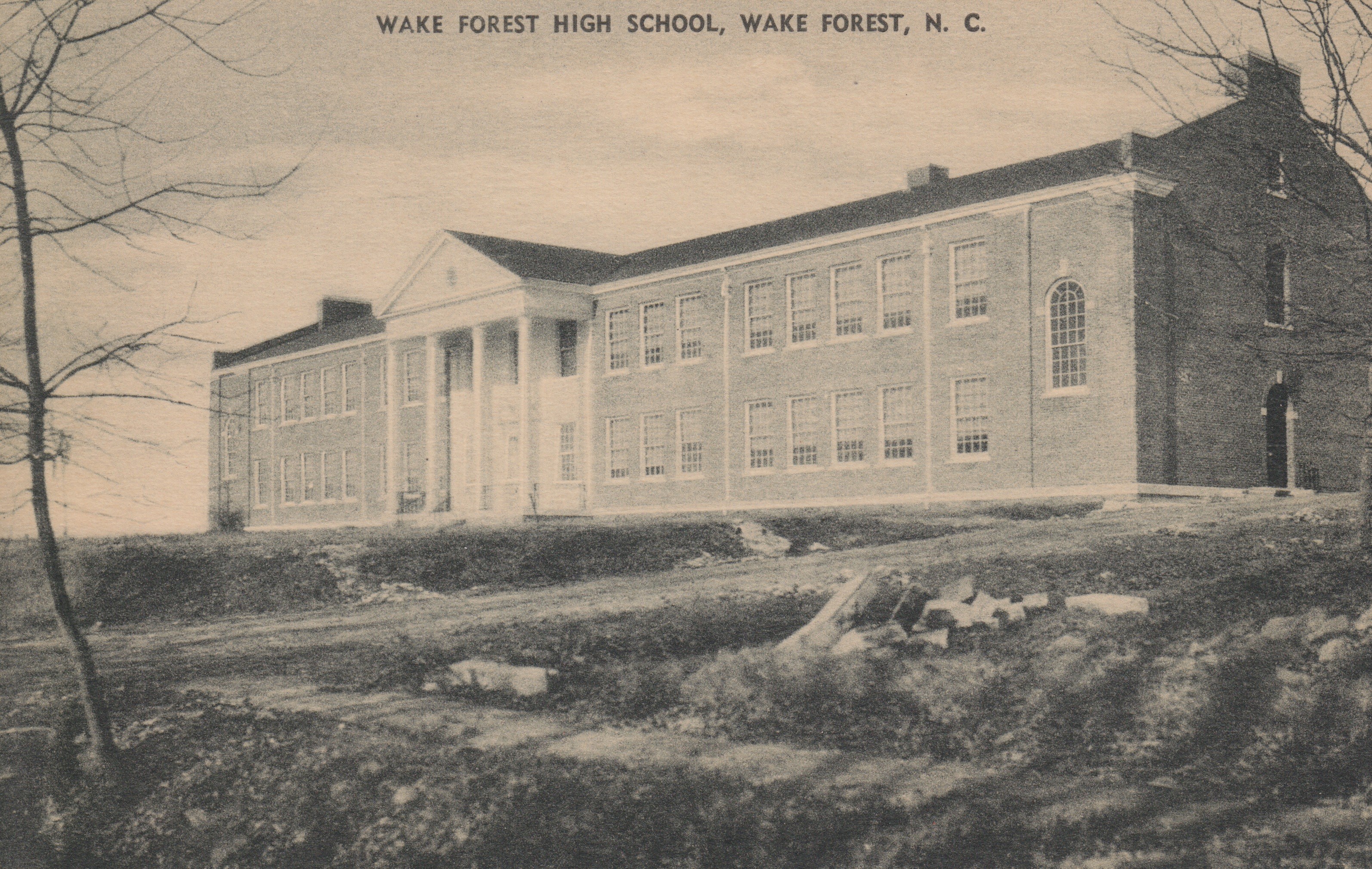
1934, Wingate Hall at Wake Forest College destroyed by fire. Blaze is discovered about 2:00 a.m. and has gained enough headway that combined efforts of Wake Forest and Raleigh fire departments cannot save the structure. Damage is estimated at approximately $65,000. Wingate Hall is the College's oldest building, as its first building, Walt Hall, burned down last spring. (February 14, 1934)
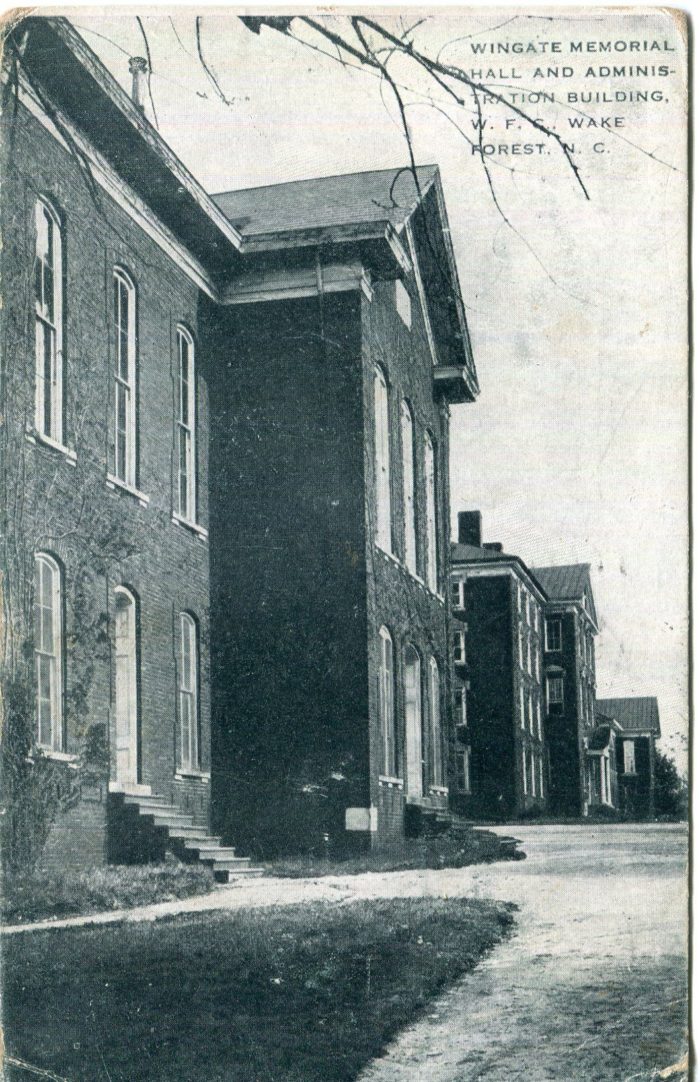 |  | 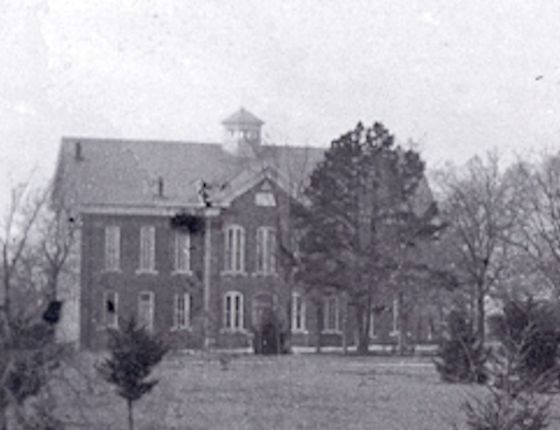 |
1934, Hunter Dormitory at Wake Forest College suffers suspicious fire. Wad of burning paper found stuffed under the floor at the south end of the building at 3:00 a.m. (February 21, 1934)
 |
1934, Wake Forest Golf Club clubhouse burns. Building is destroyed in early morning fire and believed of incendiary origin. (March 2, 1934)
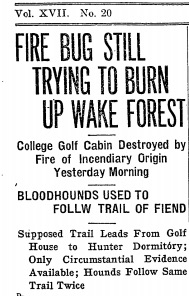
1934, "Fire Bug" attempts to set fire to the Alumni Building on Wake Forest College Campus. The fire was discovered and extinguished before any major damage. (April 26, 1934)
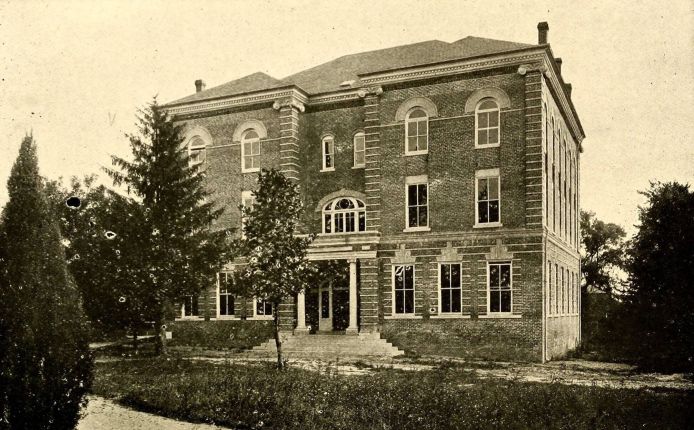
1934, Town Board begins discussions of purchasing fire truck with Barton pump, 500 GPM, on Chevrolet chassis. (October 20, 1934) tm
1935, Town Board reports that Wake Forest College has agreed to pay one-half of net amount of firefighting equipment. Mayor and Fire Chief authorized to purchase fire truck with Barton Pump, 400 GPM, on Chevrolet chassis. Cost $1524.68. (February 16, 1935)
1936, Sanborn Fire Insurance map update dated October 1936 summarizes fire department as "
- Volunteer
- One chief, one assistant chief, and 27 men
- No paid men on duty
- One station
- One Chevrolet truck, 1935 model, equipped with Barton pump, capacity 400 gallons per minute, one 150 gallon booster tank with 200' 1 1/2" hose and 1,200' 2 1/2" hose
- 800' 2 1/2" hose in reserve on rack
- Gamewell fire alarm system. 13 boxes. Alarm is sounded by electric siren
- Fire alarm headquarters located in Town Hall. (brick building). Alarm in each fireman's home."
Town water supply has "3 miles of pipe" and "50 hydrants."
1937, Town Treasurer instructed to pay firemen's per capita tax in sum of $16.50. (December 2, 1937)
1937, Town Board appoints committee to investigate cost of constructing both a steel box to store rubber boots, coats, and other "wearing apparel" and a rack for hose for the fire truck. (December 2, 1937)
1920, contracts award for construction of water and sewer systems. Water system includes fire hydrants. (March 25, 1920)
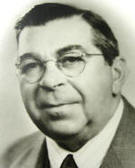
- Town Board also
- votes to excuse members of fire company from paying street tax
- authorizes Fire Chief to build "two houses, a suitable places, for reels and fire hose"
- appoints committee to consider a "suitable fire alarm" and report at next meeting to Board. (August 4, 1921)
- First fire apparatus is a hand-pulled, two-wheel hose reel with 500' of 2 1/2" hose. Same is stored at the Town water tank. A motorized fire apparatus is soon purchased.

- First location of Wake Forest Fire Department is the front of Harris’ garage which was rented by the Town for the fire department and fire truck at $12.50 a month.
- Town Board authorizes Fire Chief T. M. Arrington to purchase a chassis and body for fire truck, not to exceed $1,000. (September 9, 1921)
- Town Board approves purchase of American LaFrance fire equipment at price of $1,650. Mayor authorized to execute contract. (September 19, 1921)
1921, improvement ordered to telephone system, to include night availability and requiring that the operator given "instant notice" to each member of the fire company, for alarms reported to the "telephone office." Town Board also:
- appoints W.W. Dickson and T.E. Babbitt trustees of the Fireman's Relief Fund
- votes that $5 member fees to the State Fireman's Association be paid by the town
- Fire Chief T.W. Arrington also appointed Building Inspector
- appoints committee to investigate "suitable place for fire department". (November 4, 1921)
1921, Town Board passes "ordinances governing the regulation of the fire department and the prevention and control of fires in the town of Wake Forest, North Carolina"
1921, Town Board votes to rent front of Harris' garage for "fire department and fire truck" at $12.50 per month. Board members also vote that a fire alarm system be purchased at a cost not to exceed $385 and that two [fire] stations be arranged for. (December 1, 1921)
1922, report to Town Board from Chief of Fire Department:
- Number of members: 19
- Elected during year: 1
- Total membership: 2
- Number of companies in dept.: 2
- Number of members belonging to NC State Fireman's Association: 2
- Number of fire alarms answered during year: 5
- Number of false alarms answered during year: 1
- Total number of alarms answered during year: 6
- Value of property at risk: $21,750.00
- Damage to property by fire: $21450.00
- Insurance on property lost: $7,000.00
- Value of property saved: $15,500.00. (January 4, 1923)
1922, Town Board instructs Fire Chief to investigate different fire alarm systems and their costs and to report back before the end of the extension of the 30 days allowed for trial of the present systems. (February 2, 1922)
1923, Town Board instructs Fire Chief to order and have installed fire alarm system and have installed four fire alarm boxes. Fire Chief is also instructed to contact contractor of new school building, so schoolhouse is wired for fire alarms on each floor. In total, there are 11 boxes installed. (January 4, 1923)
1925, Town Board votes that fire department members be given their street and poll taxes. Board members also authorize purchase of nozzle for fire hose. (February 5, 1925)
mid-1920's, fire department becomes motorized. First fire truck is old Westcott automobile purchased from John Brewer and converted by firefighters into a combination chemical and hose wagon. The top is cut off of the car, a bed is constructed for hose, a basket is installed to hold chemical tanks, and provisions are made for carrying ladders.
1926, Town Board votes that fire alarm box be placed at corner of 6th Street and Rolesville Road. (July 6, 1926)
1926, Sanborn Fire Insurance map dated April 1926 summarizes fire department as "
- Volunteer, consisting of 20 men.
- One chief and one assistant.
- One fire station equipped with one Wescott truck, with American LaFrance combination hose and chemical equipment.
- 1000' 2 1/2" hose, one 60 gallon chemical tank and 200' chemical hose, two hand reels with 500' 2 1/2" hose each.
- Two 24' extension ladders, one roof ladder.
- 500' 2 1/2" reserve hose.
- Gamewell fire alarm system. 11 boxes, ringing 11 alarms in homes of firemen."
 | 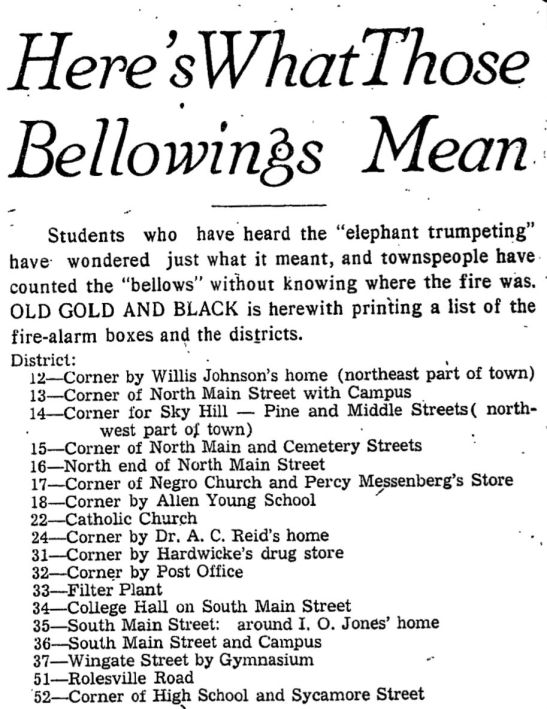 |
1927, Three buildings burn in Wake Forest. Three buildings, housing two cafes and the town's only movie theater, are destroyed by a late morning fire. Discovered about 11:00 a.m., the flames also consume a pair of barbershops housed in the second stories of two of the buildings. The Raleigh Fire Department is "summoned immediately," arriving at the college town in a mere 17 minutes. They aid Wake Forest firefighters in "checking the flames" and preventing their spread to other structures. Total damage is estimated at between $40,000 and $50,000.. (Nearly all of the fixtures of H.E. Joyner's luncheonette are rescued; the other two buildings are "but superficially furnished.") Wake Forest is located 18.94 miles from Raleigh. The fire department's 17-minute run averages 66.93 mph. (April 22, 1927).
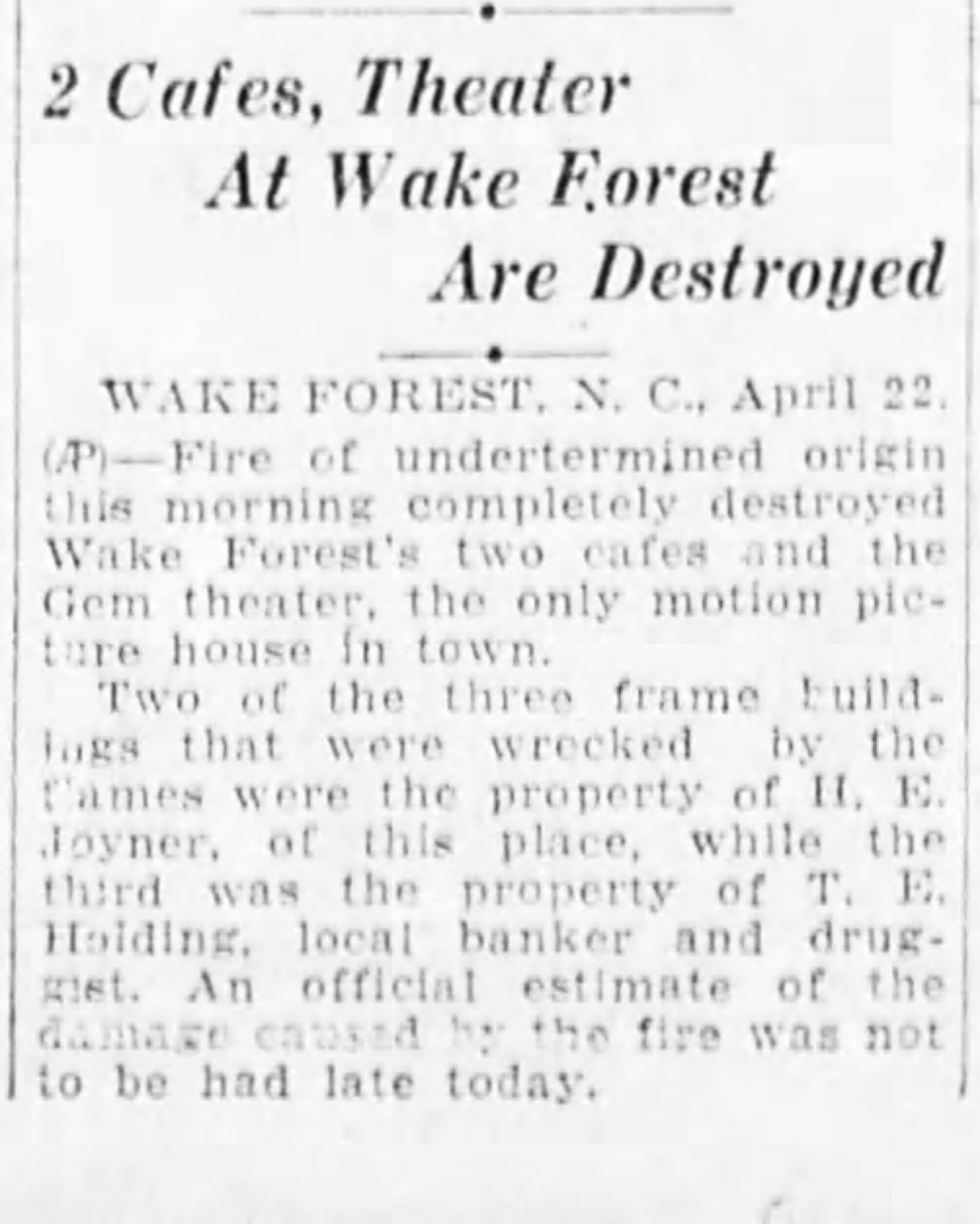
1927, Town Board votes to thank Raleigh and Franklinton fire departments for recent help. Sum of $25 to be sent to Raleigh and $10 to Franklinton as tokens of appreciation. Fire Chief is authorized to write letter of thanks. (May 5, 1927)
1927, Town Board orders $60.09 to be collected from Mr. Wisehers for damage to fire alarm box from automobile. Board members also:
- order fire alarm box transferred to corner of Main and Owen streets on motion of R. W. Wickinson
- allows each fire department member street and poll tax
- allows each fire department member $1 for each fire alarm attended and 50 cents for each drill, not exceeding four times per year. (August 4, 1927) tm
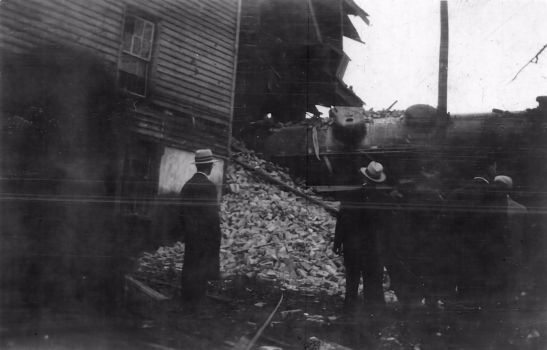
1929, T.M. Arrington again appointed Fire Chief. (June 6, 1929)
1929, fire station building committee reports that a facility can be constructed for $1,500. Town Board says they'll proceed when sufficient funds are in hand. (July 5, 1929)
1929, Fire Chief makes statement to Town Board regarding necessity of purchasing additional fire house. (November 7, 1929)
1906, Fire started at the home of Professor Carlyle's residence in the eastern part of town. Student's ran from campus to extinguish the fire but luckily the fire had been put out by neighbors.
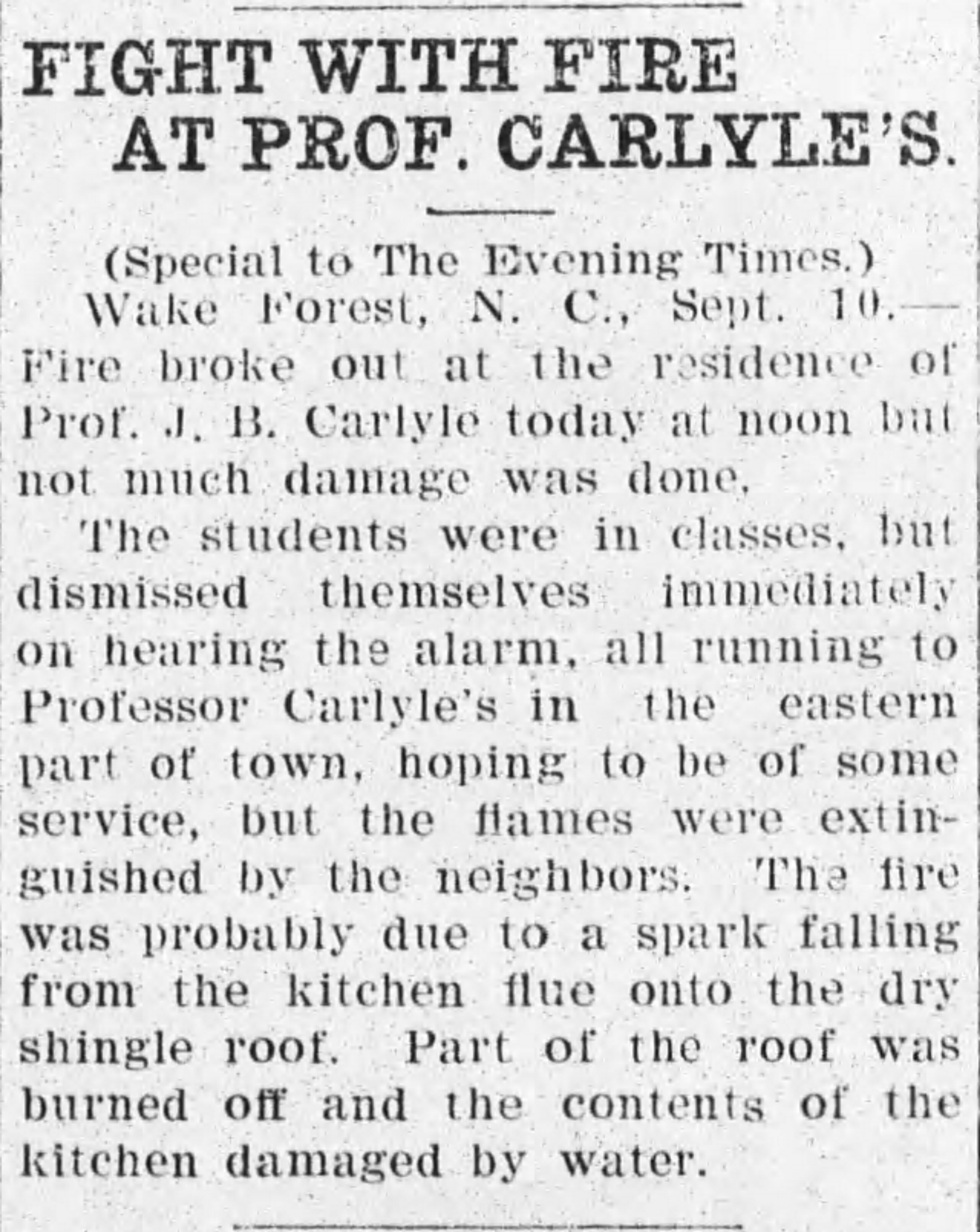
1915- Wake Forest Machinery & Hardware Company burns. The Raleigh Fire Department is summoned. Engine 1 responds, leaving at 10:10 p.m. and arriving in 35 minutes. The 17-mile run is made partly in a driving rain. A bucket brigade is working when firefighters arrive. After the pumper exhausts the 3,000 gallon water tank within five minutes, the firemen are forced to watch as flames practically gut the three-story building. They also assist with the bucket brigade, which resumes after the water tank is drained. Damaged to the building and its contents is estimated at $20,000. The company was less than a year old. The fire is believed to be "incendiary" in origin, and starts on the second floor. (June 30th, 1915)
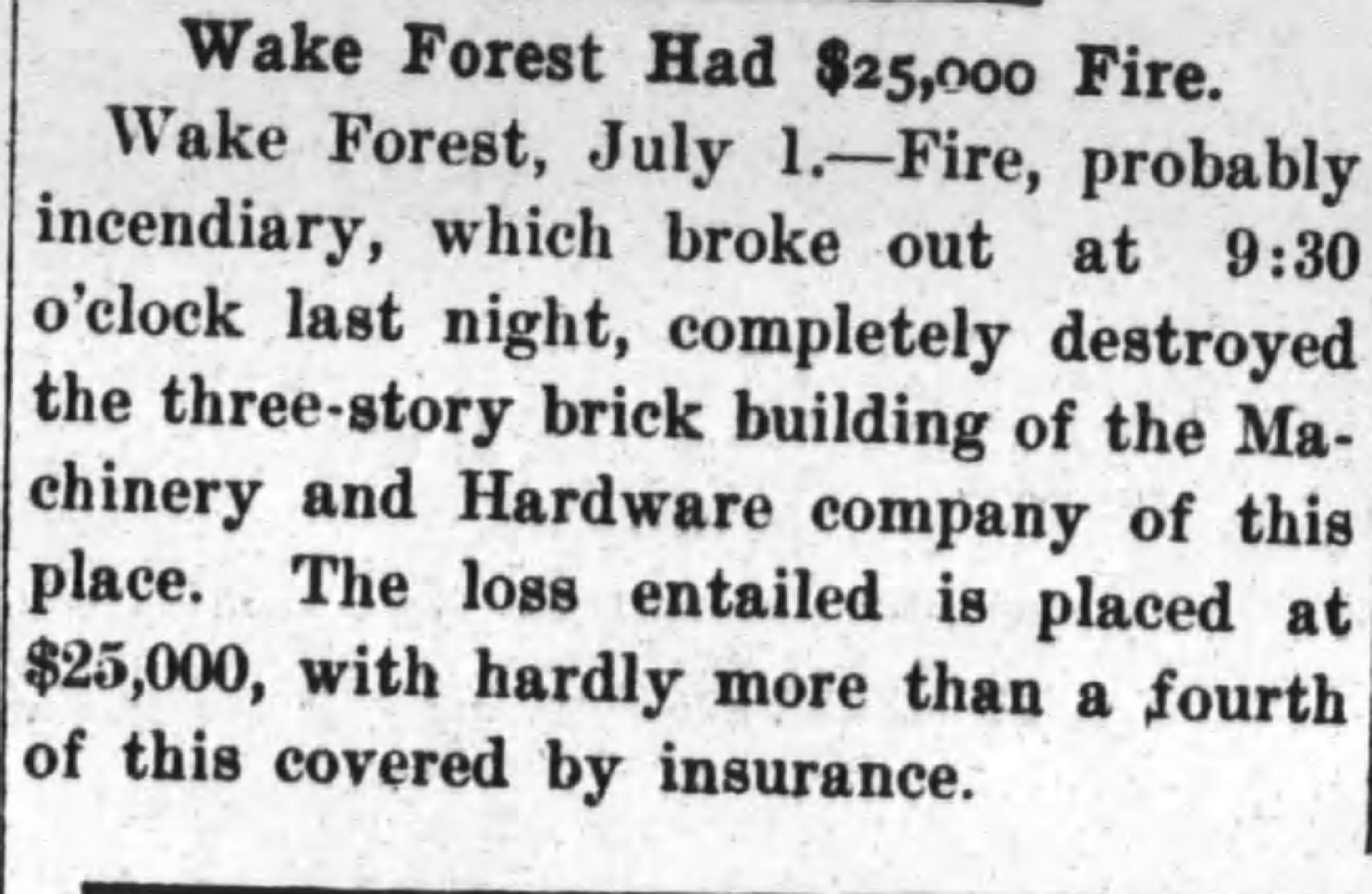
1917, fire district established, described as "beginning at the intersection of North street with White street and running on each side of White street 150 feet from the center thereof to the intersection of White street by a cross street from Main street to said cross street crossing the railroad at the Light Plant." (June 7, 1917)


